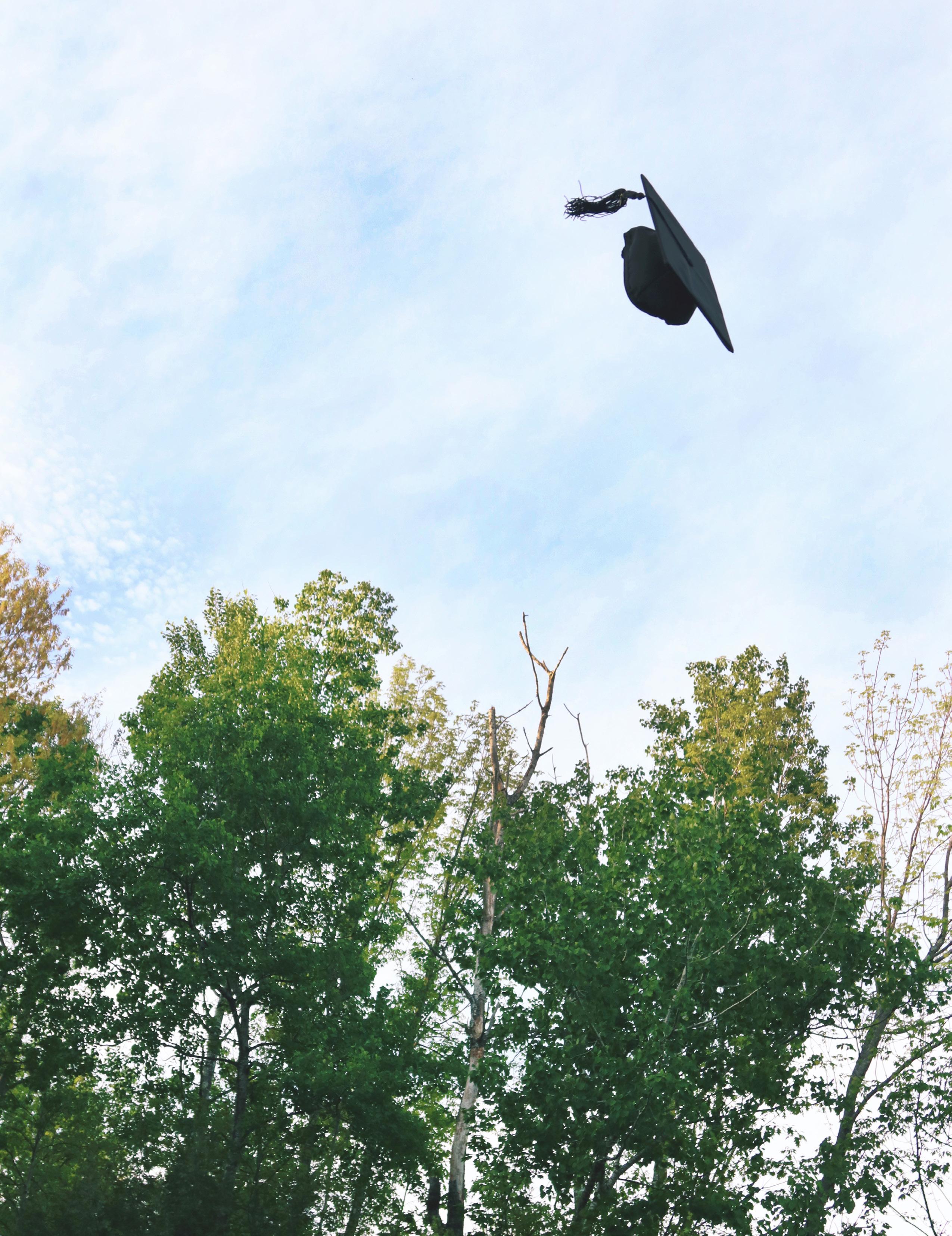




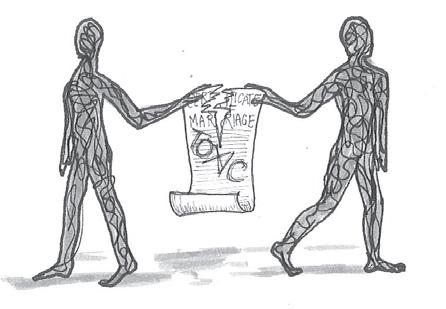
Diverse Students pg. 6

Mental Health pg. 7
Mill Pond Dam pg. 9 Venmo pg.11
Trafton pg. 13 Summer pg.15
OR Experiences pg. 17 Computer Specs pg. 19
Stone Church pg. 22 College Commits pg. 25
Best Buddies pg. 27
ORHS Artists pg. 29 FIFA World Cup pg. 31 Benching It pg. 33
Divorce pg. 35 Gun Control pg. 38

2nd Hand Clothes pg. 39 Student Voice pg. 41 Weighted GPA pg. 43
As the school year comes to an end, we are excited to present to you our last Mouth of the River publication of the 2017-18 school year. We believe that this issue represents not just the hard work that our staff has put in throughout this quarter, but the culmination of improvement throughout the past nine months.
As with all of our issues, our goal is to cover a wide range of topics, from news at ORHS to community is sues, with some lighter stories mixed in, from Phoebe Lovejoy’s coverage of the future of the Mill Pond Dam, to Abby Schmitt’s profile of ORHS Best Buddies, to Maisie Cook’s features story about Oyster River experiences she believes everyone should have before graduating.
We have all grown immensely throughout this year. At the beginning of our year, we were 19 students working individually to achieve our own goals. Over this year, we have become a staff, working together to create four publica tions that we can all be proud of. We have worked all year to highlight everyone’s strengths and use those to create the best magazine we can. We wouldn’t have the publication that we have today if it wasn’t for all of us. We strive to be a team.
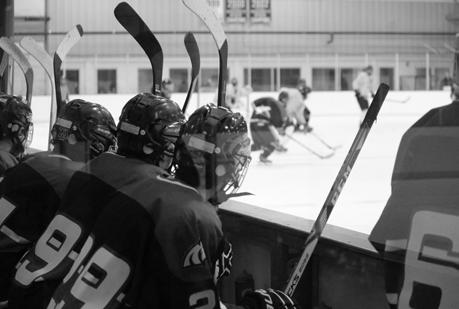
While it is bittersweet as we say goodbye to these last two years being on the Mouth of the River staff, we have full confidence that the magazine will continue to improve and thrive every year. As editors, we are just a small piece of what it takes to create this publication. Our success comes from an incredibly hard working staff and unwavering support from our advisor, Mr. Kelly. We strive every day to present our readers with high-quality journalism and reporting, and we are confident that with this idea in mind, our publication will continue to improve and be Oyster River’s primary news source. Thank you for a great year. It was an honor to be editors in chief. Yours in journalism, Anna Kate Munsey, Skylar Hamilton, and Zach Leichtman
MOR Mission Statement: Mouth of the River seeks to reliably inform the student body, as well as the surrounding community, of interesting and newsworthy content in a modern, compelling format. Our goal as a staff is to give a voice to the students of Oyster River, and have it heard by all of our students. The opinions expressed in Mouth of the River represent those of the writers and staff.
Website: https://mor.news/ Twitter: @MORmagazine Instagram: @mormagazine Facebook: @MouthOfTheRiver Podcast: http://www.morpodcast.com/
As the school year comes to a close and Issue 4 of Mouth of the River heads to print, our MOR seniors are looking forward to the new pages in their lives. No matter if they’re heading to college or taking a gap year, our seniors are excited for what the future has in store for them.


Cook will leave her beloved dog, Archie, behind as she heads to the George Washington University in Washington, D.C., next fall. Though she will miss him “to an unhealthy degree,” Cook is also excited for all the memories she will make next year as she majors in Communications.
George Washington first caught Cook’s eye when she toured, due to the fact that she knew she wanted a city school. “I’m so lucky that I’ll be getting a great education in one of my favorite cities!” she said, adding, “I’m very excited to live in DC. I can’t wait to go out and try new restaurants and take late night trips to the monuments.”
Coincidentally, exploring the city was also one of Cook’s favorite parts of Mouth of the River. “I loved being on staff with so many great people this year. The highlight of my time in MOR was definitely the trip to New York. I feel like we all learned a lot at the conference, and it was also a great bonding opportunity,” she said.
Along with missing classes such as MOR, Cook noted that leaving her family will be especially hard. “I’m going to miss my family a lot. They’ve always been so supportive of me, and I’m so grateful for all that they’ve done for me.”
Though Cook will be missing her friends from home as well, she is also excited for the opportunities George Washington will give her. “I’m really looking forward to making new friends from lots of different places next year!”
Croasdale will travel across the border to Carleton University in Ottawa, Ontario, Canada this fall. This decision came after being inspired to attend an international school by her college search, as she explained, “Canada was a great option because it wasn’t that far away from where I am now. It’s also financially beneficial because tuition is almost always cheaper, and you get the experience of being in another country while still being close to home.”
Croasdale wasn’t always planning on going to Canada for college. “It wasn’t until my dad suggested Canada that I actually started considering going international. I think I had always assumed that I would look at schools both in and out of the United States, but the more I toured Canada, the more I actually wanted to go to Canada in particular.”
Planning to major in Communications while at Carleton, Croasdale will miss coffee houses the most as she departs from Mouth of the River. “I loved organizing them and it was awesome to see such a variety of people enjoy something as a group when [coffee house] came together,” she said.
Croasdale also noted that she will miss her family and friends while she is away, but that this burden will be lessened by the fact that she, “cannot wait to experience Canada, especially because there’s going to be so much more to explore.”
Headed for a gap year in Europe to explore photography in the fall, Dundorf is excited to be able to explore more of his interests while overseas. “I’m excited to meet new people and explore different countries and cultures,” he explained.

While Dundorf is ready to head off next year, he noted that he will miss his friends, as well as getting the opportunity to work in a class such as Mouth of the River. “I loved working with my department and with individual writers on their articles,” he said. “To get more experiences like these in high school, my advice to underclassmen would be to get as many required credits as you can before senior year. If you can manage, don’t take a study hall in your first two years!”
Dundorf also mentioned that he will “miss cooking his own food,” though he is also excited to see what the independence of travel will bring in the future.
After he returns from his journey, Dundorf plans to attend the University of New Hampshire in the fall of 2019. There, with a potential major in Political Science, he hopes he will be able to use his experience with travel to better educate himself and others.
Instead of heading to college, Graff will be travelling to Costa Rica this fall. “I decided to take a gap year because I was pretty burnt out from school and had no idea what I wanted to do in college. So, I’m going to use my year to travel and do some internships to figure out life before I commit to college and the debt that comes with it,” she explained.
As Graff explores these new opportunities, she will be calling the tropical country’s Cloud Forest home as she lives with a family friend. While there, she will be nannying for them as well as teaching English to students at a local school.

Graff also mentioned that while she is excited, she will also certainly still be missing some aspects of home while she is away. “I think the hardest part about leaving home will be being separated from my family, but I know that I’ll be making friends to fill that gap,” she said.
Upon returning from her adventure, Graff plans to intern with the District Attorney at the Strafford County Courthouse, with potential plans to pursue a pre law track in the future.
While talking about advice she has taken away from her decision to take a gap year, as well as her entire high school experience, Graff noted, “leave time for yourself, and don’t worry about what other people are doing or how far ahead or behind you are. Because, in all reality, it’s your life and where you end up is up to you and no one else!”
Unlike many of her MOR staff mates, Hoffman has chosen to leave the East Coast for college and head cross-country. She will be attending Colorado State University in the fall, with a potential major in Natural Resources Management.
For Hoffman, location was one of the most critical factors in her college search, and she is excited to call Fort Collins home as she transitions into college life. “College is a perfect time to reach outside of your comfort zone and try living in an area that’s different than what you’re used to,” she said, adding, “I’m really just looking forward to being in a new part of the country.”
In this new town, Hoffman is looking forward to going on adventures with people that share the same interests as herself. “I really love spending time outdoors, and when I visited, I was really impressed with how outdoorsy and healthy everyone was. The campus itself is also really nice, and surrounded by mountains, which I absolutely loved,” she said.
Aside from the views, heading west also means Hoffman will have to say goodbye to some of her favorite high school memories, which she admitted won’t be easy. “Our school is really small, so pretty much every face in the hallway is a familiar one that I’ve been seeing for years. It will be pretty weird to hardly ever see them again.” Hoffman continued, adding, “don’t stress too much about leaving high school though, there is no better time in your life for an adventure than college.”
For Madore, deciding to spend the next four years of his life at Keene State University was made easy by the campus’ location, which caters well to his passion for climbing. “Keene is very accommodating and close to the mountains, meaning I can hike and camp in my downtime if I so choose. They also have some places to climb, which is great,” said Madore.


When not out exploring, Madore will be taking business and economics classes, as per his major in the subjects. “I’m very excited to start my next big adventure and meet new people,” he explained. “But I’ll also miss the connections I have made with people at Oyster River and seeing those faces every day.”
As for what he’ll miss most about Mouth of the River, Madore will remember the times spent bonding as a staff most next year. “My favorite MOR memory would have to be when we all went to Nick [Dundorf’s] house for the bylines because it was just very cozy and overall a lot of fun.”
From MOR, and high school in general, Madore feels like he’s learned a lot. “My advice to underclassmen would be to not worry about the little things and to just relax,” he said. “Enjoy the little things, because you’ll end up missing the sports teams and the school spirit of ORHS when you leave!” Photo by Chris Sleys
As Moore heads to Rochester Polytechnical Institute next year to study Human Centered Computing and Artifi cial Intelligence, he touched upon some of his favorite Mouth of the River memories. “I really enjoyed when we all went and had Thanksgiving together because, even then, we had already gotten so close as a staff.”
While Moore will miss times like these, he is also excited for what’s to come. “I’m really excited to be individual and on my own in the world while at college. I am also looking forward to making lots of new and more diverse friends from places that aren’t Durham, NH,” he said, adding, “I’m also really excited to start studying the subjects that inter est me and to move away from the ones I am not interested in.”
For Moore, these subjects of interest were just one of the things that drew him into attending Rochester Polytech nical Institute. “I really loved the atmosphere that existed there when I toured... also [RPI] has a really focused way to help you choose the right major and specialize within that major. They also have a really incredible co-op program that I look forward to taking advantage of, as well as a strong focus on learning through hands on experience with small class sizes,” he said.
These factors, combined with the fact that Moore was especially interested in the options the school gave him for potential majors, made the decision easy. “As for my major, I have really enjoyed the classes I have taken with computer science while in high school. Artificial Intelligence is something that always interested me no matter the context, so it seemed like the right choice,” he said.

Murphy has decided to attend Elon University next year, with potential plans to be a Physician’s Assistant in the future. Though she is looking forward to warmer weather and meeting new people, she will also miss her friends, family, and “especially my cat, Clyde.”

She is also looking forward to catching up with friends about their own college experiences as the year progresses. “I can’t wait to come home during breaks and hear all about my friend’s colleges and gap years,” said Murphy.
In terms of what she will miss most from Mouth of the River, Murphy noted that “shooting the bylines and taking the Issue 1 cover at Wagon Hill has been my favorite memory so far.” Murphy also added that she enjoyed the creative aspects about taking the staff’s photos each issue, which is something she’ll miss in the future.
While giving advice about high school, Murphy noted, “I would say don’t stress too much. The random homework assignments and poor test grades you’re worrying about really aren’t as important as you may think. As long as you have good work ethic and motivation you’ll be set for college!”
Quest has chosen to defer from the University of New Hampshire for her first year out of high school, which was a decision she made out of uncertainty. “Next year I want to do some traveling for the first half of the year and then possibly get in internship for the second half,” she explained. “I chose to defer because I’m really uncertain of what I want out of my college experience and going right into college would be a very expensive way to be unsure.”

During her gap year, Quest admitted that she will miss the “social aspects of high school,” along with Mouth of the River. “I’m going to miss the newsroom environment and all of the people in MOR next fall. They’re all wonderful and I was happy to work with them for a year!”
Quest also had advice for future staff members, which are things she picked up over her last few months as the Features editor. “Write articles you care about! It makes it so much easier and then end up being better articles. Also stay on top of deadlines and try to not leave things all to the very last minute,” she said.
Aside from Mouth of the River, when asked about what else she will miss as she heads off, Quest answered, “All of my friends, I can’t single out just one. They’re all so loving and supportive and I wouldn’t be who I am today without them.”
Though Speechley is currently enrolled at the University of New Hampshire with plans to major in English and Journalism, she admits that she might take a gap year to explore her passions of photo and videography. “My top school in New York City was too expensive and UNH doesn’t have a photography major, so I just figured that I really want to do is travel and explore the world and possibly land some cool internships or jobs along the way.”
Speechley is toying with the idea of turning such travels into a YouTube channel, where she could showcase her expe riences alongside her abilities of shooting and editing footage. This project would mirror Speechley’s work with Adobe’s InDesign during her time as a Mouth of the River staff member, as both give her the option of making her work come to life. “Personally, I always loved doing the layout for my articles. Writing an article is a pretty long process and I always looked forward turning into a visually appealing piece at the end of the quarter.” Photo by Sophia Graff
Next fall, Zwart will be making the short trip north to Dartmouth College where she will be taking full advantage of the school’s liberal arts style. “I am planning to take classes in a number of different areas, but ultimately, I am planning on majoring in Nutritional Science or Environmental Studies with a minor in French,” she noted of her potential decisions.
For Zwart, picking a place to call home for the next four years was challenging at first. “There were just so many schools and options, and I was worried I would miss out on my ‘perfect school’ by not looking into and visiting the right ones,” she said. “However, I realized that that were many schools that I would be happy at, and it was perfectly okay and normal to feel overwhelmed.”
In choosing Dartmouth, Zwart is confident that she made the right decision in terms of where she will be the happiest. “Next year, I’m super excited to go somewhere new and meet new people, especially since I’ve lived in Durham and gone to school with the same people since kindergarten! It’ll be an adjustment, that’s for sure, but I also think it will be exciting.”
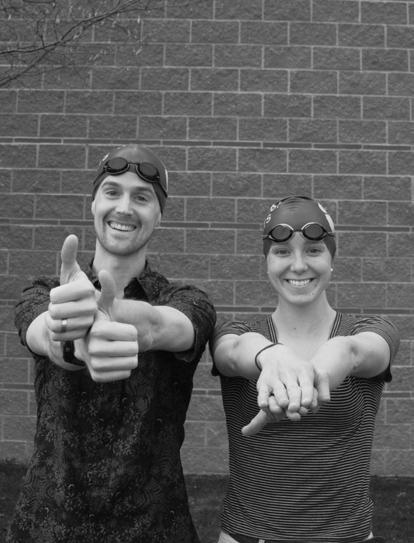
Part of this adjustment will be missing home, explained Zwart, “I will miss my friends, my teachers, and the Durham community for sure. In the same sense that I am excited to meet new people, it will be hard leaving faces that I am used to seeing every day.”

Though before her departure from high school, Zwart had several pieces of advice to the grades below. “Take time for yourself and take time to have fun. The work will still get done and high school is an incredible place to connect with your teachers and do fun things with your friends before everyone parts ways.”
After a successful year as one of Mouth of the River’s Co-Editors in-Chief, Hamilton will be heading to the University of New Hampshire to continue exploring journalism.
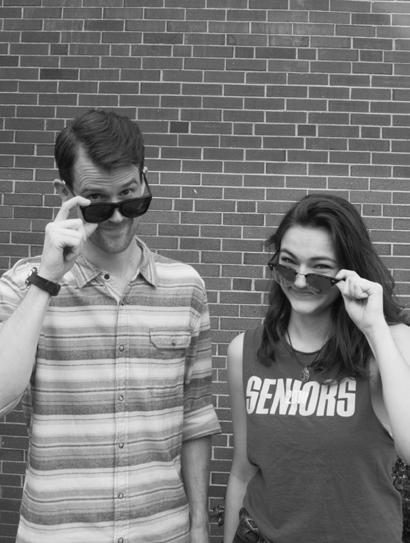
“There is no doubt that Mouth of the River has helped to prepare for the next chapter of my life,” Hamilton said of her choice of Journalism as a major. She then continued, “I also have loved the connections with people I’ve made on staff, espe cially with Mr. Kelly. My favorite part of Mouth of the River has definitely been how professional it is and I have loved being a part of something that has been so much bigger than just a high school class.”
In addition to enjoying MOR, Hamilton also enjoyed her time spent in the theatre department over the past four years, and admitted that she will miss her time there. “I’ve really found my place in the theatre department and with all the amaz ing people involved in the shows. It has been so nice to find a place where you feel welcomed, and I hope I’ll be able to find a place like that next year at UNH.”
In addition to potentially joining a theatre group next year, Hamilton is looking forward to all the other perks college has to offer. “When I toured UNH, I realized that I definitely wanted a school with a campus and sports teams with overall school spirit. I ended up picking UNH for those reasons, and also for all the opportunities that UNH will provide, given it’s such a big school. Because of this, I will have the opportunity to try out many different classes and clubs, allowing me to find out exactly what I want to do with my life,” explained Hamilton.
Hamilton also added that while she ended up choosing UNH, she benefited from applying to a diverse group of colleges and encourages others to do the same. “I would suggest applying to a wide variety of schools because you never know what’s actually going to feel comfortable to you when you look to commit to a college. For years, I thought I wanted one type of school, and when it really came down to it, I now want something completely different,” she said.
“I don’t know where you came from, but over here we participate.”
These words were spoken by a teacher at Oyster River High School, directed at Yasmeen Gunandar (‘20), a Mus lim student at ORHS. According to Gunandar, this is one instance of the numerous charged comments and threats that have led to her helping to form the Diverse Students’ Union.
The club was formed earlier this year to create a safe space for students to learn and discuss issues of racism at ORHS. “The reason why we started this [club] is because all of [our members] have had instances where we have been called names because of our skin color and our religion,” says ORHS student Hannah Grass (‘20). The group, advised by so cial studies teacher Gabrielle Anderson, seeks to address how the school is responding to issues with the district’s culture. With meetings every Tuesday after school, the DSU plans to address racism as well as faulty responses to racism. Its members also stress that all students are welcome to join and partake in club activities.
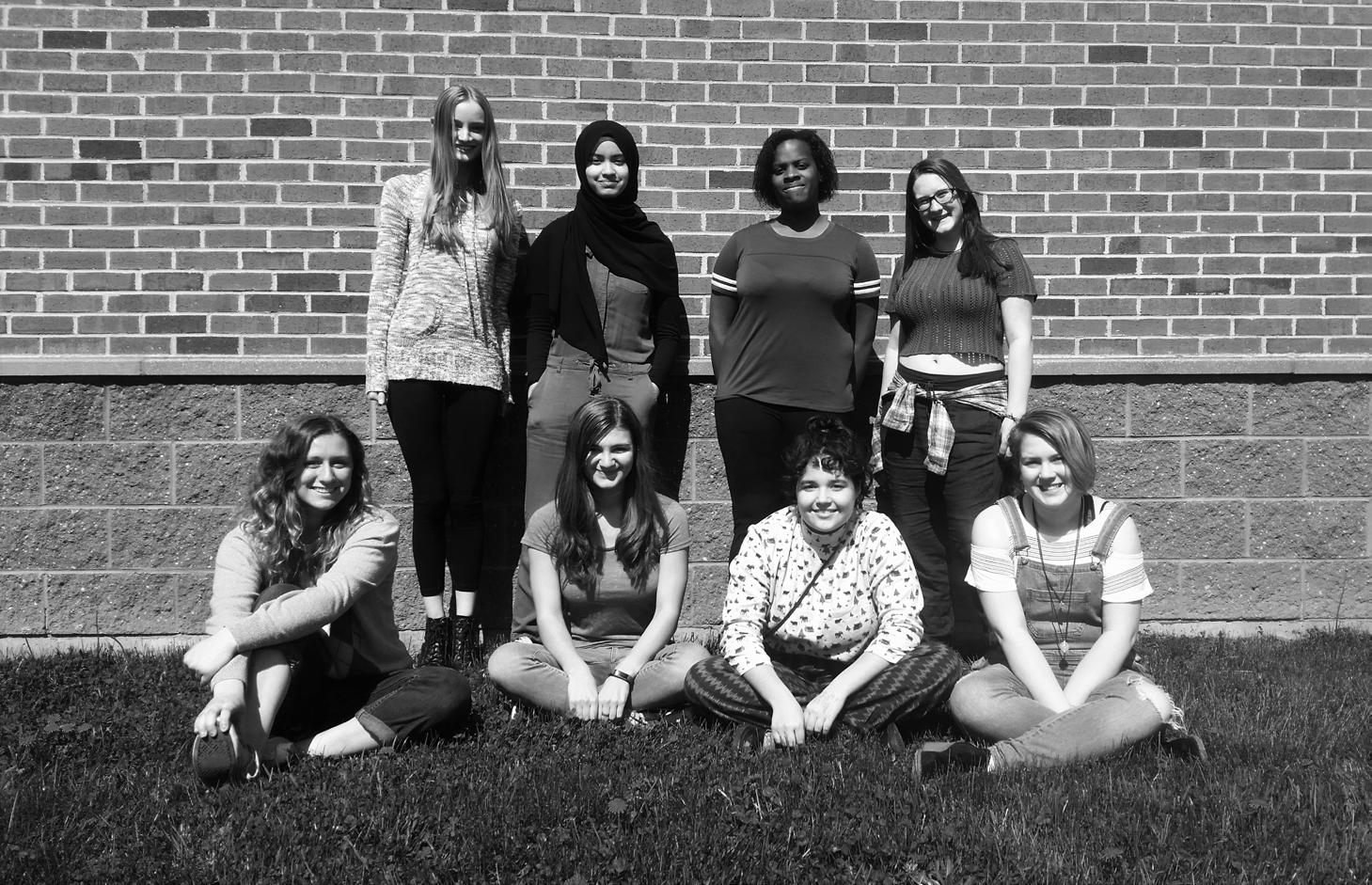
“I’ve been telling all these things to adults in school, and I don’t think they’re taking us seriously,” says Gunandar. A major part of their initiative, the members feel, is that they haven’t received adequate support when they have reported other students’ aggression. Gunandar continues, “I’ve had things happen to me like people sending me texts, calling me a terrorist. On Snapchat, it was 9:11 at night and they sent that to me with an airplane emoji and a twin towers emoji.”
The DSU members also hope to overcome misconceptions about bullying at ORCSD.
“For some reason kids think that [bullying] doesn’t exist, just because they haven’t experienced it. I think that’s the same with racism. How could they know if people experience racism at school?” says ORHS student Liv Forcey Rodriguez
(‘20). Grass and Gunandar echoed this sentiment, comment ing on the dangers of online bullying or more subtle forms of racism, often referred to as “microaggressions.”
The district’s responses to racial incidents earlier this year included a public forum on diversity as well as mandatory di versity training for teachers. The DSU members appreciated these efforts, but feel that more must be done going forward. One major initiative that they are working on is having a diversity forum intended for students. While they are excited for this potential next step, the members express concern with how previous efforts have been received.
“[With] the diversity training that the teachers have had, many teachers have been complaining about it. It’s hard being one racial kid in the class and they’re talking about it to the entire class. You’re upset because diversity training is import ant,” says Gunandar.
This sentiment is shared by many of the other DSU mem bers, including Jane Schwadron (‘20), who says, “these adults are not taking it seriously if they’re complaining about [di versity training]...It’s sad because these adults are supposed to be our role models, but they’re complaining about it.”
While they feel that they are on a long, bumpy road, the students of DSU are hopeful of what they are creating. “We want kids to come in and feel comfortable telling their stories about what’s happening in our school,” says Grass.
The members hope that creating a safe space will open the door for meaningful discourse—or at least a space to vent and feel more at ease after a long week. Besides the club’s interpersonal support, its students look forward to pushing for greater education and training to protect students from racism.
-Nicholas Dundorf by Nicholas Dundorf“This award has given me the confidence to continue advocating for mental illness and better mental healthcare. Knowing that I am recognized for my actions motivates me to continue fighting for a stigma free world. This starts with our community,” stated Grace Smith (‘20).
The National Alliance on Mental Illness (NAMI) recognizes a student and teacher from New Hampshire annu ally for their efforts to advocate for mental health awareness. This year, out of every school in New Hampshire, the student and educator awards were both granted to members of Oyster River High School. Sophomore Grace Smith was awarded the Unsung Hero Award. Director of ORHS Drama Department, Meredith Freeman-Caple, was the recipient of the Educator of the Year award. On Saturday, April 21st 2018, the NAMI New Hampshire awards cere mony was held in the Grappone Center of Concord to recognize Smith and Caple.
The play, One Flew Over the Cuckoo’s Nest, was directed by Caple and performed earlier this year by ORHS students. This play is the main reason why Caple was recognized by NAMI. Cuckoo’s Nest takes place in the 1960’s at a mental institution that the main character, Randle Patrick McMurphy, is trans ferred to for evaluation. In the mental institution, the head nurse, Nurse Ratched, takes advantage of the patients and Mc Murphy convinces them to rebel and stand up for themselves.
After having read the book, watched the movie, and acted in the play, Liev Manck (‘19) explained that the theme of Cuck oo’s Nest was not mental illness. He acknowledged that mental illness played a large part in the story, but it was used “mainly to set up the greater themes and ideas.” He concluded that Caple deserves this award because of how the larger themes of mental illness were added in by herself. “Being a director who adds themes to a preexisting script is an extraordinary thing,” said Manck.
Caple’s husband, Scott Caple, and Anne Duckworth from NAMI frequently worked with the students participating in Cuckoo’s Nest. S. Caple is a registered nurse at New Hamp shire Hospital in Concord, which is an involuntary state mental hospital. S. Caple and Duckworth worked with the students “to identify what behavior they might display [for their char acter],” said Caple. She believed that with the help of S. Caple and Duckworth, the actors could become knowledgeable on their character’s illnesses, which in turn could help the students portray their characters more accurately. The cast had many deep conversations into the depths of mental illnesses with Caple, S. Caple, and Duckworth. There were “talkbacks after the play every night with the cast and the community about mental illness,” Caple added.

The inspiration for Smith’s advocating of mental illness arose from her brother, Samuel, who was diagnosed with a form of schizophrenia soon after graduating ORHS in 2015. “Wit nessing the stigmatization of Sam and his illness inspired me to want to take action. I started with my Power of One project; my topic was mental health awareness.” Smith made lime-green ribbon pins and distributed them throughout the community on the night of her Power of One project. “My parents, who have connections to NAMI, sent in a picture of the pins to the orga nization. They took immediate notice and asked me to make 250 of them for their state conference,” said Smith.

After NAMI saw the pins Smith had made and her grow ing passion for the cause, she was asked by NAMI to speak at ORHS’s performance of Cuckoo’s Nest talk back. Smith ex plained that “the audience was able to communicate and ask questions with the performers and some NAMI representatives, including myself.” A friend of Smith’s, Emily Shuman (‘20) added that “she shared her whole story and didn’t spare any of the details.”
Smith also participated in the 2017 NAMI Walk in Concord, NH. Smith was a team leader in the walk out, where she raised over $2,000. “All of this was done on my own time, driven by my own passion and desire to bring awareness to such an im portant cause,” said Smith. She went on to express that mental illness is “inevitable, and is something that affects every person in some way.”

For Smith, “being the sibling of someone suffering from one of the most stigmatized mental illnesses, receiving this award has given my brother, Sam, the reassurance that I am willing to do anything to support him.” She plans to continue advocating for mental illness and hopes that in sharing her experience, she will encourage others to fight for the same cause.
Schuman spoke highly of Smith, saying that she has done a lot for herself, the community, and “most importantly her family” to earn this award. Smith has enlightened the communi ty of ORHS as to how to look at mental illness in a serious and professional way. Schuman concluded that “she is an inspiration to me for sure, and a lot of other people. Grace 100% deserves this award.”
Smith would like to share a personal message to her commu nity. “Words are our strongest form of communication. I hope that everyone who reads this can stop for a moment and think. How are my words affecting others? Do I really know what is going on in their life? Because the truth is, you don’t. You don’t know if using a certain word could offend someone. Be consci entious, courteous and aware of how you affect others. I hope that our community can move past labels and start recognizing people for who they are. Not all people who suffer from depres sion are antisocial. Not all people who suffer from schizophrenia are violent. We need to let go of these labels which do not define a person. A mental illness is just another obstacle that some of us face and therefore it should not affect someone’s view on another individual.”
“The Mill Pond Dam is essentially choking a vein of Great Bay,” says Jon Bromley, environmental science teacher at Oyster River High School.
In February of 2018, the New Hampshire Department of Environmental Services officials said they identified key issues, such as concrete degradation and exposed rebar, with the Mill Pond Dam of Durham during a December inspection. The letter called on the town to repair or reconstruct the dam by 2020. The Mill Pond Dam is unique and historically significant because it is 101 years old -- the oldest Ambursen style dam in the state, and in 2014 it was added to the State Register of Historic Plac es. Repairing the dam could cost the town up to five million dollars and restoring water quality would cost another million dollars on top of that, leading town residents to wonder whether it’s worth keeping the dam at all. Removing the dam would be the most cost effective and environmentally friendly but it would mean saying goodbye to a town treasure.
“The dam is iconic,” says Andrea Bodo, a member of the His toric District/Heritage Commission and strong advocate for the dam; “it is a scenic treasure for those passing by on Route 108.” She adds that dams have been at this site for 368 years and are an important part of Durham’s history.
“By preserving historic structures, we are able to share the very spaces and environments in which the generations before us lived,” says Bodo.
The dam was once the center of Durham’s commerce, and was a philanthropic gift to the town. According to the dam’s application to state historic resources division, Edith Onderdonk paid for the construction of the dam to honor her step father, Hamilton Smith, in 1913. The engineer for the project was Chas Elbert Hewitt, the first chair of the Department of Electrical Engineering at UNH.

Nowadays, the pond created by impounding the Oyster River is an attraction for picnics and recre ational activities. If the dam were to be removed, the pond would cease to exist as we know it.
Abby Croot (‘18) lives near the Mill Pond and enjoys photograph ing the area, as well as kayaking in the summer, and walking her dogs there. She says, “I love crossing the bridge every day and would hate for the dam to be removed.”
Owen Fleischer (‘21) also lives nearby; it’s a big part of his life as well. “My family and I play a lot of pond hockey and skate up and down the Oyster River tributary, and I fish in the Mill Pond almost every morning of the summer and fall,” he says.
“Historic preservation is the visual and tangible conservation of cultural identity.”
-Andrea Bodo
Unfortunately, the dam and pond have a number of issues that require expensive repair. According to Rob Sullivan, for mer conservation commission chairman, the dam has created a water quality issue in the Oyster River, one of Durham’s three primary drinking sources. It is more affordable to get rid of the dam than it is to fix it, and there are various state and federal agencies that will provide grants to financially support the work to remove the dam. Some feel that this option makes the most sense.
The dam is a trap for sedi ment, mud, and nutrients. As a result there has been a build up of fertilizer, nitrogen, and phosphorus, which encourage overgrowth of plants and algae. This, and the blocked migra tion of fish, negatively impacts wildlife and the water quality.
“The big picture is that we’re part of a system larger than us, and Great Bay is struggling. I would argue that Great Bay’s health is more important than our history with the dam,” says Bromley.
Bromley supports the removal of the dam; he believes “we shouldn’t put money behind something that doesn’t benefit us anymore.”
Sullivan says that the conservation commission has not yet come to a conclusion on the dam, and that the future of the dam will likely be up to the voters; it depends on whether they
want to put their money behind it. “The state has mandated that something needs to be done within three years, so the clock is ticking,” he says. Ultimately, the town has to bring the dam into compliance with the NHDES Dam Safety requirements outlined in the 02/12/18 Letter of Deficiency.
According to NH’s restoration coordinator, Kevin Lucey, the state’s Letter of Deficiency to Durham also establishes a December 2019 deadline by which the Town of Durham must submit environmental permit applications for dam reconstruc tion.
A lot of issues are consid ered at sites where dam removal or dam reconstruction is being considered. This includes a review of existing and historical sediment information, water sup ply impacts, recreational usage, visual and aesthetic consider ations, and more.
A date has not been set to vote on the issue, however it will be discussed in town council meetings and conservation com mission meetings. A calendar for these meetings can be found on the town of Durham’s website, https://www.ci.durham. nh.us/.
Bromley says, “your opinion of the dam depends on whose history you’re interested in. For a town in New England 100 years is a long time, but 100 years is nothing in ecological history.”

“We’ve altered the landscape in a way that is out of sync with the ways nature wants to behave.” -Jon Bromley
-Phoebe LovejoyPhotos by Town of Durham website
Youreyesflickerexcitedlyoverthecoffeemenu,thelineof peopleaheadwaitingtoorderdecreasingbytheminute.Youcanfeel thesameexcitementradiatingoff of yourfriend,whoisinlinerightinfrontof you.Then,asyoureachagiddyhandintoyour pocket,disasterstrikes.Allof asudden,mullingoveryourdifferentmilkoptionsanddecidinghowmanyshotsof chocolateyou wantinyourcoffeeistheleastof yourworries.Where’syourcard?Yourremaininghandfliesintotheotherpocket.Where’syour cash?Devastationhitsyoulikeablowtothestomachasyoucometotermswiththefactthatyousimplyputonthewrongpair of jeansthismorningandwill,infact,notbepurchasingacaffeinatedbeverage.Thankfully,yourfriendregistersthetragedyand swoopsin,offeringtopayforyou.Youpromisetopayyourfriendbackandtheyshrugnonchalantly.“Don’tworryaboutit.Youcan justVenmome!”Younodpolitely,butasyouleavethecoffeeshop,youhavejustonethoughtrunningthroughyourhead:Whaton earthisVenmo?
Venmo, created in 2009, is a social app available on both iOS and Android. Owned by PayPal, it is used to transfer money back and forth with anyone you choose. As cash and checks seem to be blasts from the past these days, Venmo offers a much quicker and easier solution to paying people back, and getting paid back in return.
“I love Venmo for its convenience,” said Kagan Conrad (‘18). “It’s so much easier to pay people back for stuff when you don’t have to use cash and can just pay each other with a text. It also makes things a lot easier when paying for a meal or movie tickets with someone else.” Venmo can be used for something as simple as paying your friend back for lunch, or something as serious as a business transaction.
As a Venmo account needs some kind of financial source, it can be connected to a card, bank account, or used through your Venmo balance. According to PayPal, your Venmo balance is the money you have received from others paying you. When you pay for something using Venmo, the money will be pulled first from your Venmo balance, and then if more is needed, it will be pulled from your main funding source. Keep in mind, Venmo transactions only work between people with Venmo accounts.
In general, Venmo does not have a transaction fee, however if you are using a credit card the company charges a 3% fee.

According to Moneyish.com, people exchanged $17.6 billion on Venmo last year.

Due to Venmo’s practicality and simplicity, it seems the app has become very popular at Oyster River High School, with its primary consumers being the student body. But are teenagers the only ones who use Venmo?
“Anyone can use Venmo,” said Abbie Rogers (‘18), who first heard about the app from her two brothers who are in college. “Apparently everyone uses it in college to pay people back for things,” she said. “A few weeks ago, I bought coffee for one of the moms at my dance studio, and she paid me back through Venmo. I would absolutely recommend Venmo to everyone!”
However, while Conrad also recommends Venmo to his friends, he sees Venmo being used for potentially darker activity.
“To be entirely honest, besides myself using Venmo, I mostly see other people using it for what looks like buying drugs,” said Conrad. “I think that mostly teenagers and young adults use it, but honestly anyone can. I got my parents and Mrs. Stetson using it, [and] they both seem to enjoy it.”
A variety of people seem to be using Venmo more and more for their everyday tasks.
“I use Venmo to pay babysitters [and] to pay for services people provide, such as mentoring children,” said Laurie Car rera, an adult venmo user. Carrera heard about Venmo through friends and was drawn to the convenience of the app. “I don’t use it a lot, but when I do it’s worthwhile. I can see it being helpful for various age groups. Having cash is not common [and] checks are a hassle because they involve cashing them. The direct transfer of funds is great,” she said.
Venmo is not everyone’s cup of tea. Some don’t see it as par ticularly helpful and are cautious about what it might do to their spending habits.
“I do think Venmo is a good idea, I just don’t think it’s some thing I’ll be including in my life anytime soon,” said Kendall Bird (‘18). “I really just don’t have a use for it. And I’ve been try ing to be more aware about what I do with my card lately, just trying to be more responsible with its security. I’m not saying [Venmo is] not a secure app because I think it is, but I’m trying to be more aware.”
However, Bird is not the only one thinking about the security of the app.
“Of course I worry about my bank account information being accessed for fraud,” said Carrera. “I don’t know if there are rea sons to be concerned that my transactions are being tracked, but for now the pros seem to outweigh the cons. I have not done the research to know if I should be more concerned about fraud or tracking, but that would be a big concern potentially.”
After researching the security of the app, it looks like
Venmo has put forth some security measures to keep people’s information safe. The company uses encryption and storage to keep people’s account information private and the company has instructions on how to access your account and sign off of the app in case you have lost your phone.
“The only con I can really think of is that the default setting for transactions is public so anyone you’re friends with can see who you’re paying,” said Conrad. “It’s really easy to make it private though, so I’ve never had that issue. Also it is one more place where your credit card or bank information is kept so it’s liable to be hacked. Venmo encrypts everything however so I’m not super worried.”
Venmo has managed to cultivate quite a following from a variety of people leaving only one true con remaining.

“The only downside is that before I had Venmo I could get away with telling my friends I would pay them back later and then never doing so,” said Rogers with a chuckle. “With Venmo I’m forced to pay them back right away.”
-Hannah CroasdaleFrom Durham to Nashville and Israel to New York, Evan Gordon, an Oyster River High School graduate, has spent the past two years pursuing a career in the music industry.
Now located in New York, Gordon has multiple songs on Spotify, Apple Music, and SoundCloud. He is collaborating with other young artists, and is excited to release a few tracks he has been working on recently. Gordon creates pop music inspired by artists such as Lorde, Banks, and Glass Animals under his artist name, Trafton, a family name. The music industry is incredibly competitive, and Trafton is working tremendously hard to earn a spot.

Trafton graduated from ORHS in 2016 with plans to attend Belmont University, in Nashville Tennessee, and major in Music Business. However, once he got there, he began to realize that Belmont was not right for him. Halfway through the school year, he made the decision that he would not return the follow ing fall. “I just wasn’t happy there,” he explained. Although his initial plans did not work out, Trafton said, “I don’t regret it at all because that was the first time I met other people who were artists and serious songwriters. I found out that I have some thing, and that it is worth pursuing.”
Trafton realized that he wanted to be an artist and be di rectly connected to music, and decided to apply to a competitive musical program offered at New York University (NYU). He had been admitted his senior year of high school, but due to financial reasons, decided not to attend.
Trafton felt confident that he would be admitted again. His
backup plan: travel the world. When the decisions came out, he was rejected. “I was like, ‘well sh*t, I need to figure out how to do this,’ because I had told everybody I was going to go travel if I don’t get in,” recalled Trafton.
Trafton packed the night before his six month trip across Europe. There, he gained confidence in himself through travel ing. He knew he wanted to pursue a career in the music indus try before he began his trip, but it gave him time to think. “It was solidifying,” said Trafton.
After his expedition, he planned to go home for a week, then fly out to Los Angeles, California to work on his career there. Trafton knew that this was a bold plan but as soon as he got home, he joined a Facebook group in which people listed avail able apartments around Los Angeles. His dad encouraged him to join one based out of New York too. “He has a better chance of success in New York because he is closer to home and the support of his family. New York City also happens to be one of the most artistically driven places in the world, especially in the world of music,” explained his father, Daniel Gordon.
“I found out that I have something, and that it is worth pursuing.”
He connected with someone who was leaving their Man hattan apartment and wanted to rent it out. It was a perfect fit for Trafton, who is now living there. He figured this experience would help him transition this fall, as he plans to attend Baruch College in Manhattan.
In New York, he has been partnering up with people he met when he had been admitted to NYU and trying to make con nections within the music industry. “It hasn’t been as fruitful as I had been ambitiously hoping,” admits Trafton, but he has not stopped trying. “I’m meeting a lot of people, and making a lot of music that I know has legs,” he said.
The first hurdle is the hardest to get over in the music industry. “It’s not always reasonable or rational. Nobody will pay attention to you, unless someone else is paying attention to you,” he explained.
Although Trafton is “at the startline still,” he has not been discouraged. His sister, Laurel Gordon (‘19), described her brother as, “driven and determined.” She explained, “he loves what he does. Once he has something in his head, he won’t stop until he does it.”
Trafton explains that he has “strong visions for what I want my persona, my image, and my music to be.” Although he is trying to write more commercially, he does not want to change his style or compromise anything that makes his writing unique.
“He has a real creative vision in his head. He wants to take this nebulous vision and channel it into this finished product that is really representative of what he feels,” said Amy Trafton, his mother.
Trafton gets his inspiration from anything that affects him emotionally. He focuses on “writing the song and creating the music so that it sounds like how it feels.” He explains that his work is “an emotional process as much as it is an intellectual or technical one, because, in a sense, it’s a conversion from pure experience and thought and feeling into words and sound that people can consume and understand.”
In addition to his creativity and dedication, Trafton is a hard worker. “He works assiduously at perfecting each piece. He doesn’t just throw it out there. He works it and works it until he likes what he has,” explained Daniel.
Although Trafton still has a long way to go before he ‘makes it’ in the music industry, he does not display any signs of giving up. “Working in the music industry is my number one goal,” said Trafton. He does not have a backup plan. “If you have big aspirations, you can’t have a backup plan or else you’re just going to go for the backup plan,” he advised.
Trafton plans to release three new singles on Spotify, Apple Music, and “wherever else people listen to music” this summer.

“It’s not always reasonable or rational. Nobody will pay attention to you, unless someone else is paying at tention to you.”
-Lydia Hoffman
“If you have big aspirations, you can’t have a backup plan or else you’re just going to go for the backup plan”
“Summer is the perfect time to travel and pursue activities that you would not have the time to do during the school year. By pursuing things like job internships, camps, work, or travel you are able to not only make great memories but better yourself as a person,” states Jareer Labadidi (‘18)
Many Oyster River High School students plan to spend their summer working, hanging out with friends, and staying within the general confines of the Durham community. But some ORHS students have decided to spend their summer vacations differ ently, by travelling to a different location, completing a job internship, or pursuing hobbies in hopes of bettering themselves or the world around them.
Instead of using your summer as a time to relax on the beach, which is a perfectly acceptable activity and use of your vaca tion, it could also be worth your while to look at different opportunities that you can pursue to further yourself as a person.

Kendra Hooper (‘20) plans to spend a month of her summer with Sail Caribbean, a program that will have her traveling through the Caribbean on a catamaran sailboat. While in the Caribbean she will be participating in activities like tagging turtles and recording marine wildlife, as well as providing clean up assistance to the island of Torto la, which was hit by hurricanes earlier this year.
Hooper looks at this trip as a way to become more independent and take on more responsibility, as she has to work together with a team to get tasks done.
“With all of the responsibilities and adventures I will have, I will be able to find out more about who I am,” stated Hooper. Hooper is also looking forward to the other activities that will be happening during the trip, like scuba diving and snorkeling, along with making new friends and memories with the members of the service program.
Signe Kula (‘20), an avid runner, biker, and swimmer, will continue to participate on a national triathlon team this upcoming summer. She has been training almost every day, and will continue training for her competitions throughout the whole summer. Although this is a huge time commitment for Kula, she does not look at it as a chore.
“The motion of the sport, the switching of focus during each portion, I never get bored. I choose to do them not only for the love of the sport but the people around me, ” states Kula.
Kula, who had maintained a winning record while competing in kid triathlons, impressed national triathlon coaches at the age of thirteen with a 1st place (in the sixteen and under age group) win at the New England Kids triathlon.
Despite feeling doubts about being able to handle the competition at the national level, with a little help from mentors in her life Kula decided that she was ready. Even though the transition from local to national level was tough, Kula has shown that the fierce competition of being on the national team hasn’t phased her.
“The local community is kind and fun, absolutely amazing. The national circuit is different. It’s intense and competitive but just as amazing, because I love the challenge.”
She will be competing in pre-qualifier races in Virginia, Wisconsin, and Iowa later this summer.

Si LaBelle-Brown(‘20), enthusiastic hiker and camper, will be traveling and living in San Diego California for a month this sum mer, as well as spending a week hiking in the Sierra Nevadas.
Brown, who visits San Diego every summer, looks forward to the trip as a way to reconnect with his family.
“I chose to go there in the summer because it’s very nice there and that’s the only time I have away from school. I also think it’s important for me to visit not only my dad, but my family that lives out there even if it is only for a month,” states LaBelle-Brown.
Although LaBelle-Brown’s main reason for flying out to California is because of family, he also enjoys the perks that come with it, which include the beautiful mountains and living nearby the ocean.
“I love to go hiking with my dad. It’s just fun to go out and spend time with him outside in nature. I just really like the views at Convict Lake.”
LaBelle-Brown plans on hiking in the Sierra Nevadas at Convict Lake with his family while out there, as well as experiencing the local culture of San Diego.

Labadidi (‘18) will be completing an internship with an orthopedic surgeon at Tufts Medical Center later this summer. He looks at this internship as a way to not only get experience in the orthopedic medical field, but also to make connections with professionals within that field.
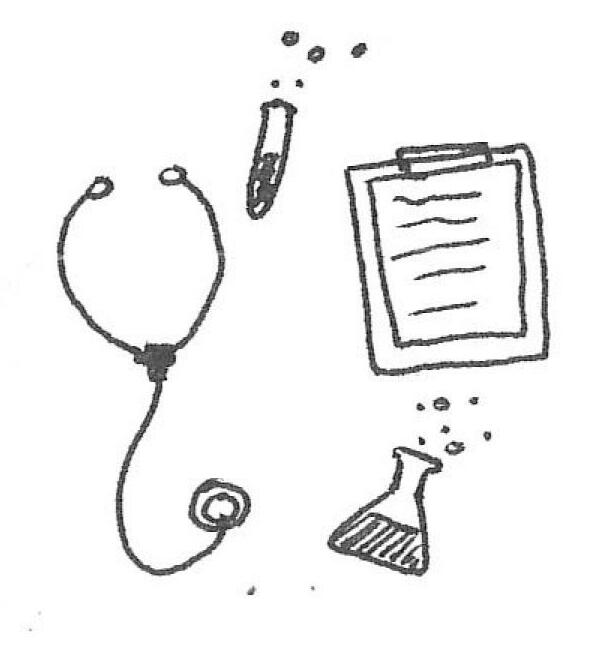
During the internship Lababidi will be following around a surgeon, and will observe surgeries, help administer tests, take vitals, and learn about the day to day life of being a medical professional.
With guidance from the orthopedic surgeon he will then be able to start interacting with patients and do things such as ordering scans and coming up with diagnoses that will later be dis approved or approved by his mentor.
Labadidi looks at this internship as a way to help further his passions for medicine, and gain fur ther insight into the medical field before attending American University of Antigua (AUA) College of Medicine this upcoming fall.
“Although it will take up a portion of my summer, and I may miss out on certain moments, I think that doing internships in important places with important people and doing them well builds up connections, and for me that far outweighs the missed time spent out on the beach during the summer.”
Although traveling the world, going across states to compete in national competitions, or securing an amazing internship are cool things to look back on in life, you shouldn’t feel bad if you personally are not able experience sailing through the Caribbean or competing in national races.
Summer is the best time to discover new interests, broaden your own personal hobbies, or work towards a personal goal you have for yourself. But, unlike most of the people in the article, that doesn’t mean you have to travel halfway across the world or find an amazing internship in order to pursue your own passions.
Many people are able to further themselves as people right from the comfort of their own home town by volunteering in your local community, finding a job, or even pursuing internships within your town’s local businesses.
If travelling to another country or even another state is not in the cards for you, you can still find a cool local spot that you and your friends can go to this summer. Or maybe try and snag that ice cream scooper job that is posted in your local ice cream shop. Any experience during the summer can help better you as a person, and help you figure out what you will want to pursue later on in life.
- Sophia Graff Artwork by Sophia GraffAs a senior nearing the end of my time in high school, I feel like a wise old woman who has had the life experience to impart her knowledge on younger generations. Through all of the joyful, anxiety-provoking, and downright bizarre experiences I’ve had at Oyster River, I’ve taken away some valuable life lessons that I’ll carry with me long after I graduate. Here are some experiences you need to have as a student at Oyster River that will not only make for great stories, but will also benefit you in ways you would never expect.
Ahhh, good ol’ oyster rumor. If you’re not familiar with this term, it’s one that’s been used for years to describe the speed at which gossip spreads around the school and how twisted information gets as it’s passed from student to student. These rumors pertain to various subjects, ranging from the difficul ty level of a test, to the details of a certain student’s personal life. What may start out as a snarky comment or joke to a friend can spread throughout the school like wildfire in minutes, and by then, the meaning of what you’ve said has been completely taken out of context. “One person will say something, and it becomes like the game telephone. People just exaggerate the story to the point where it becomes a way bigger thing than it actually is,” says Char lotte Clarke (‘18). While it may not sound ideal to have the whole student body talking about you, it can actually be a good thing. Rumors can be about positive things too. In addition, as your name gets around the school, it may lead to you gaining social media followers, or maybe someone will take interest in you and ask you to prom.

You haven’t experienced a true shaming until you’ve come face to face with Dean of Faculty, Mark Milliken, on a Friday, and you’re wearing neither flannel nor floral. A few years ago, Milliken decided that one of the two patterns should be worn each Friday to show a little school spirit. If you’ve recently gotten in trouble with the administration, and you’re absolutely desperate to get on their good side again, you’re sure to win over Milliken by participating in flannel/floral Friday. Even if you’re not a troublemaker, participating in these festivities could help you form a friendship with Oyster Rivers beloved Dean of Faculty. “Mr. Milliken makes such good connections with students, and he’s such a positive influence on all of us,” says Ben Antognetti (‘18), a frequent participant in flannel/floral Friday. So whether you’re trying to impress Milliken, or you’ve just got a fresh new Hawaiian shirt that you’re dying to wear, flannel/floral Friday is a worthwhile experience you need to have before your high school career ends.
I’ll never forget where I was when it was announced that parking passes would be given out through a lottery system. It was like World War 3 had broken out. Students were enraged by the thought that they wouldn’t be able to whip onto Coe Drive every morning and show off the sick wheels on their 2007 Honda Pilot. “I didn’t get a pass junior year, and I had no other way to get to school. It was a huge struggle,” says Taylor Mills (‘18). While most of my peers were absolutely infuriat ed, my wise 16 year old self saw a lesson in all of this. The disappointment that students would face from not getting a park ing pass would just prepare them for even more severe let downs they may experience later in life. Fighting to have a parking pass is definitely something you need to experience in high school, as it will only help you build character.
Use your free period to go downtown for coffee instead of doing homework
Sure, you’ve got a big anatomy test tomorrow that you should probably study for, but you have an Aroma Joe’s gift card that’s practically begging you to use it. And frankly, will you even be able to memorize the inner workings of the nervous system without a little caffeine in your circula tory system? Of course not. “The adrenaline rush you get from only having a few minutes to haul downtown, get your coffee, and rush back in time for class never gets old,” says Henry Bulkley (‘18). So rather than using your 50 minutes of free time to make a dent in your flashcards, consider treating yourself to a delicious beverage. And let’s be hon est, you deserve a reward for all your hard work.
You’re not even 10 minutes into A period on Wednes day morning, and you still haven’t completely woken up yet. Then an intriguing yet familiar smell catches your senses. “The scent from the cafe on omelette days is irre sistible. It immediately makes you hungry,” says Ben Clem ent (‘18). You ask your teacher to go to the bathroom, and 15 minutes later, you return to class with a ketchup stained shirt. Normally, a teacher would be mad about a student lying about their whereabouts, but it is omelette day for goodness sake, and how can anyone be mad when the scent of their favorite fried egg dish fills the air?
If you’ve ever been to the third floor on a day when it’s above 75 degrees outside, then I bid you my heartfelt condolences. If you’ve been blessed enough to not encounter that body odor filled nightmare, then I have some tips on how to keep it that way. If you have a class on the third floor before E period, then you’re probably in the clear, as the temperature is most likely still bearable, and not enough body odor has collected to make a lasting impact. If you’re less fortunate, and you have a class on the third floor after E period, then you have two choices. Either you could fight through the copious amounts of sweat filling your every pore for the sake of your education, or you could just get dismissed and go to a climate controlled setting. I recommend the latter, but don’t just take it from me, “When you have your G period class on the third floor, your main focus is airing out your shirt rather than taking the notes on the board,” says Emerson McManus (‘18). Don’t think of this as skipping class, think of it as self care. Trust me, you’ll thank me later.
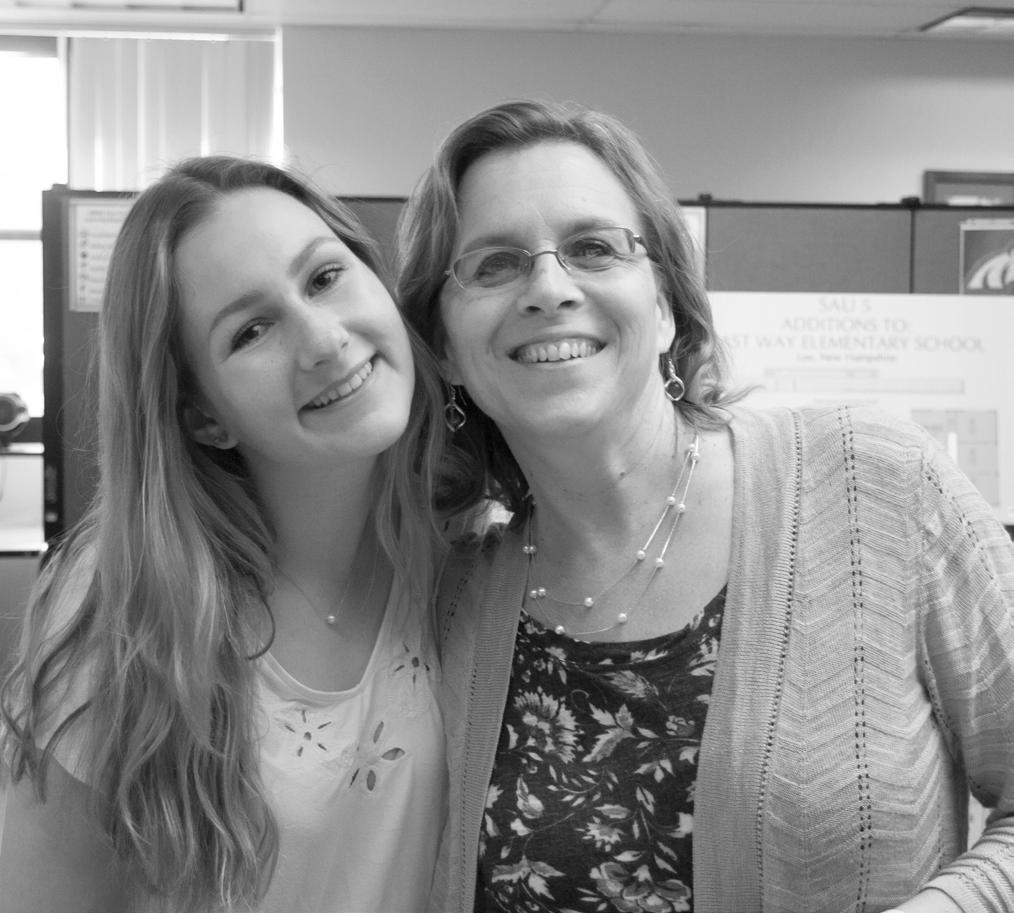
It is now 8:16am. You sprint to the front door and hit the buzzer as your feet nearly freeze to death in your Birken stocks, which you so wisely chose to wear in mid February. Finally, the door unlocks, and you make your way to the front office to be greeted by your favorite familiar face, Lisa Richardson. After a stressful morning which caused you to be late, no one will turn your day around quite like her. Whether she gives you a compliment on your outfit, or you share a chuckle over some witty banter, Richardson is sure to put a smile on your face. “Mrs. Richardson is the best!” says Clover Kelly (‘19). “She even has a nickname for me. She calls me four leaf, like a four leaf clover!” While the repercussions of your tardiness may be negative, the friend ship you form with Richardson will make up for that.
I hope that you feel more wise and prepared for your upcoming school years after reading these tips. May the remainder of your time at Oyster River High School be just as weird, wild, and wonderful as mine have been.
Understanding all of the weird techy words that you see on the sticker.
You walk into the Apple store hoping that you’ll walk out with a new computer or laptop. You check out the regular MacBooks, and see that one has an Intel m3 processor, and another has Intel i5. They both have eight gigabytes of RAM, but then you notice that the 13 inch MacBook Pro’s all have Intel-i5 and eight gigs of RAM as well, but the prices are much higher than the non-Pros. What on earth does all of this mean? Why are the costs so vastly different?
RAM determines your computer’s ability to essentially mul titask by working with more information all at once. The high er the gigabytes in RAM, the easier it’ll be to have Photoshop, Final Cut Pro, and Youtube open all at once. Typically, a solid amount of RAM is eight gigs, but the more the merrier. You can actually buy sticks of RAM, but good luck trying to add it to a laptop, since most do not support upgrades. One of the reasons why building your own desktop computer has become so popular is the ability to remove worn out or outdated parts and replace them with more technologically advanced pieces in order to keep your system up to date. It is also more eco nomically sustainable, so you don’t have to buy an entirely new computer once something breaks or fails. One thing to keep in mind is that your RAM power can be completely undermined by a poor performance processor.
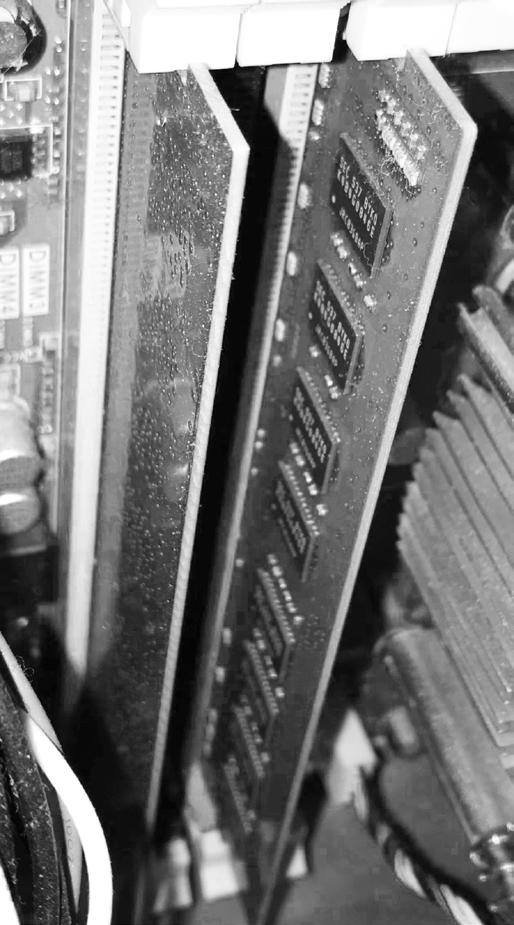


Your processor is the brain of your computer; it takes commands and instructions and executes them accordingly. We’ve all seen Intel commercials and their stickers on comput ers, which is one of the leading manufacturers of processors, along with the brand AMD. An Intel Xeon Gold 6154 can run you around $3,500-$4,500, but unless you are doing some insanely complicated stuff on your computer, the average Joe is not gonna need it. One thing you’ll notice with CPUs is that it will have some number followed by “GHz”; this is what we call “clockspeed”, which measures how fast your processor can execute a task in gigahertz. A term you might hear is “over clocking” or turbo-boosting, which is where you can set your processor to work faster than what the manufacturer has set as the default.

As technology has advanced, CPU’s have more “cores” and are able to execute tasks just as efficiently, but need to have a lower GHz output, or else it might end up melting like ice cream on a hot day in L.A. This explains why some of the most expensive, high end processors have a low GHz number and a fan attached to it. If you want to find which CPU is right for your price range and their overall performance, check out cpubenchmark.com, where scores are given to different models so you know what the leading processors are.




The GPU renders images that go to the display. Of course your mon itor/screen shows how nice everything will look, but the graphics card will generate what shows up on it. They are found in almost every elec tronic device that needs a display, like consoles and phones. Intel makes their own graphics cards, but NVIDIA is the brand most gamers, graphic designers, and video editors reach for. You can add multiple GPU’s to a singular computer, which is quite popular with people who mine bitcoins, a heavy mathematical process that can be done faster with a GPU than a CPU, and has ultimately driven up the price of these nice graphics cards.

”I spent $400 on mine. It is awesome, I got it so I could play a certain game that I couldn’t play before.” says senior Connor Barski, who recent ly purchased an NVIDIA Geforce GTX 1070 graphics card.


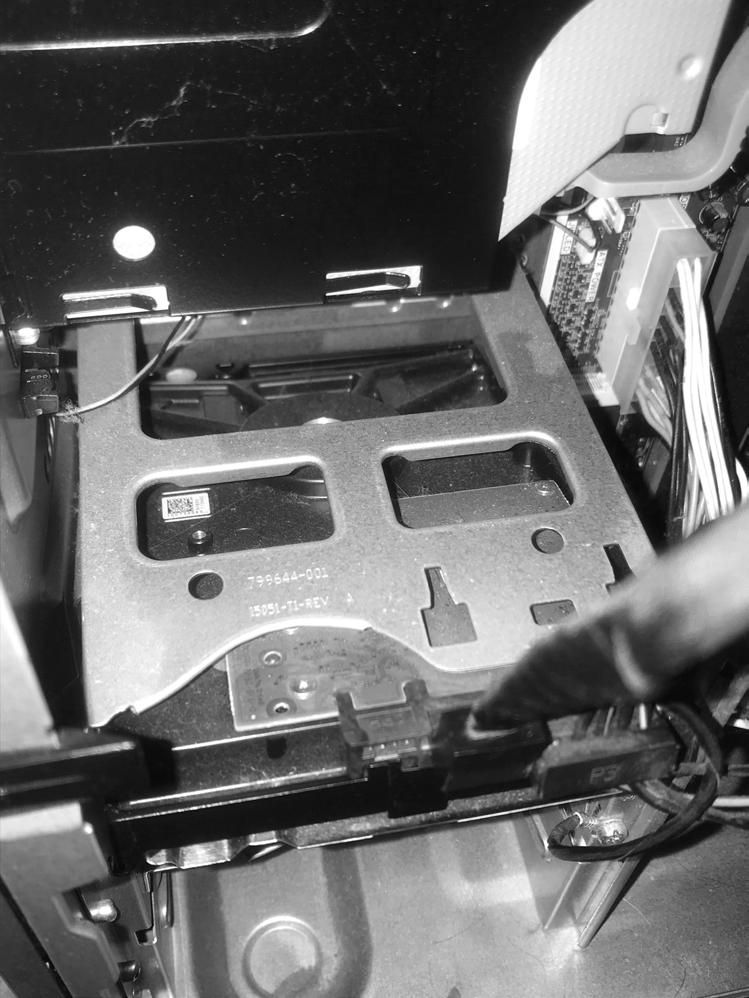
The back of the GPU actually reaches the exterior of the computer, where you can find VGA, DVI, and HDMI ports. These are where you would plug in a monitor.
Hard drives are the component that most people are familiar with. They look like little record players where information can be stored, accessed, and overwritten with new content. They are complicated little devices, which use magnets, “plat ters” and spindles. Storage can vary from computer to computer, with most laptops having anywhere from 500GB-1TB. Some abbreviations you might encounter are “HDD” and “SSD”. Hard-disk-drives are typically bigger in size, but commonly have more storage for cheaper than solid-state-drives, which are thinner and more suit able for lightweight laptops since they are thin and flat and have no moving parts. A video producer is going to need a lot more storage than a writer since videos take up a lot of space compared to a word document, which is where you need to decide what is best for your wallet. SSD’s are typically pricier than an HDD since they’re newer technology and have low demand, but both can be used together in one sin gular computer.
“A solid state drive will cut down on boot up time compared to a normal hard drive, which has a disk that needs to search for information on. A solid state doesn’t need to spin a disk to look for anything, it’s just all right there.” says Oliver Philbrick, a senior who casually talks about hard drives in public. “Solid states take up more space per gigabyte, so a $300 laptop might come with a terabyte of storage, which is a thousand gigabytes. A more expen sive laptop that comes with a solid state drive might come with about 128 gigabytes.”
A major drawback to an SSD is evidently the price. A 4TB HDD will run you about $90, where a 3.84TB SSD is $9,030. “You don’t go and buy one of those unless you are doing one very specific thing.” says Adam Hookway (‘17) to Philbrick. “If you want an all purpose, versatile computer, like if you want to edit and store videos, or make music and store audio files, or play video games, a solid state won’t work for you because you’ll run out of space,” closes Philbrick.
A true Apple fan, computer teacher Cathi Stetson owns two MacBooks and a Mac desktop, but also uses the school-issued touch screen Dell laptop and a PC at home. As for what she prefers, it “really depends” on what she is doing. “If I’m doing photography related items, I do like some of the software that goes on my Macs, which can also be done on a PC, but for some reason, I just like my Macs better. I like to have both, but if I had a choice and if I had to get one thing, I would get Macs.”
Stetson notes that there are some significant differenc es between Apple and PC products when it comes to up grades. “I bought a Mac where I can’t upgrade the RAM, so I did go buy a PC because it was more cost effective for me to buy something with an i7-core processor and 16GB of RAM, and I find I can do a whole lot more. I goofed when I bought my iMac. I assumed that I could pop the back and add more RAM.”
As for what she recommends for students, she says it depends on what your goals as a student are, and your overall budget. “If you’re going to college for art and design and things like that, I would probably recommend a Mac if you can afford it, but truthfully, getting a PC is not a detriment to those type of things either, so I think whatever you can afford. Obviously, a Chromebook is just for using online tools, but if you can afford a $200 Chromebook, then that is the tool you should have,” says Stetson.
MacBooks are known for their clean and crisp displays, and also have a lot of features that don’t come standard on a PC. “If you’re going to be a designer and you’re serious about it, probably the Mac. They come with Pages, Key note, and stuff like that is probably a really good thing, so you are getting some more software that you wouldn’t get on a PC.”
In the end, it typically dwindles down to what you can afford, and Stetson advocates for students to purchase within their means. “Macs are not cheap, but I always find too that I never have any problems with viruses. I do not even have any virus protection on any of my Mac prod ucts, but I’ve never had an issue, knock on wood. PC’s I can’t always say the same; they are more vulnerable to attacks.”

Oyster River senior, Sean Glennon, built a PC that cost him roughly $200 after acquiring some components for free, and says that it only took him an hour and a half to build it from start to finish. “It’s mostly just plugging stuff in, but it also took me an extra 23 hours to get it to work since I had a crappy power supply.” Glennon says people commonly overlook the PSU (power supply unit), where your computer can be rendered useless without ample electricity being pumped into it. “If you get a really bad power supply, it could ruin your whole computer. The one I have is powerful and reliable, but if the computer ever shuts off without me turning it off properly, like the power going out, it takes me 45 minutes to get it started again.”
As for smaller details that can be overlooked, “Put the spacers in between the motherboard and the backplate. I forgot to do that,” says Jake Weglarz (‘18), who also built his own computer. “My computer worked for a year, but then I tried putting a firewire cable in, and it just did not work. Remember spacers.”
Glennon and Weglarz both agree that most of the PC building budget should be put towards the processor, “When all else fails, go for the processor. That’s the heart of the computer.” says Glennon, but also recommends that CPU also needs plenty of RAM in order to optimize its capabilities. “It’s like buying a really nice car and having bad tires on it.”
As you walked around the Apple store, you opt to go for a laptop that has Intel i5 over the Intel m3 processor after checking their benchmarks online. You see the cheap est MacBook Pro only has 128GB of storage, which you don’t think will be enough for your work. The next step up is 256GB, which brings up the cost by $200. Do you want to spend an another $300 for a touchbar? Or should you just stick to the standard Pro? Should you get the 15inch for almost $1,000 more? You quickly observe that the non-touchbar Pro has a slightly faster processor, seeing that you can turbo boost it 3.6GHz. You ultimately decide to save yourself the $300 and just get the $1,500 13-inch MacBook Pro.
- Jess Speechley“If you’re going to college for art and design and things like that, I would probably recommend a Mac if you can afford it, but truthfully, getting a PC is not a detriment to those type of things either.”
are some of the famous musicians that have performed just min utes from Oyster River High School.
Tucked away up on a hill is one of the most iconic places in mu sic history, and we’re lucky enough that it’s right here in Newmar ket, New Hampshire. Aside from the artists mentioned above, The Stone Church has been home to a long list of incredible artists over the years. Some came locally and some traveled here just to perform. Although The Stone Church has been home to many of said performances, organizations, and events through various ownerships, all owners have had the same goal in mind: running a successful music club that people want to spend time at. Current owner and parent of a student in the ORCSD, Mike Hoffman, has been working for the past year to keep the dream of creating a welcoming music venue alive.
The Stone Church started in 1841 as a Universalist Meeting House. The goal was to create a place where any type of people could feel welcomed. Over time, The Stone Church went through various owners and became home to many different things, one of which being the first Catholic church in New market. In the 1950s, the build ing became a shoe factory, which soon suffered a horrific fire. In 1969, the building was sold to three students, one of which being Rod Philbrick, who all fixed the building back up to be able to use again. These students wanted to create a “forever Woodstock” vibe that The Stone Church still has to this day.
In 1970, Philbrick was a student at the University of New Hampshire who took over The Stone Church with his two friends.
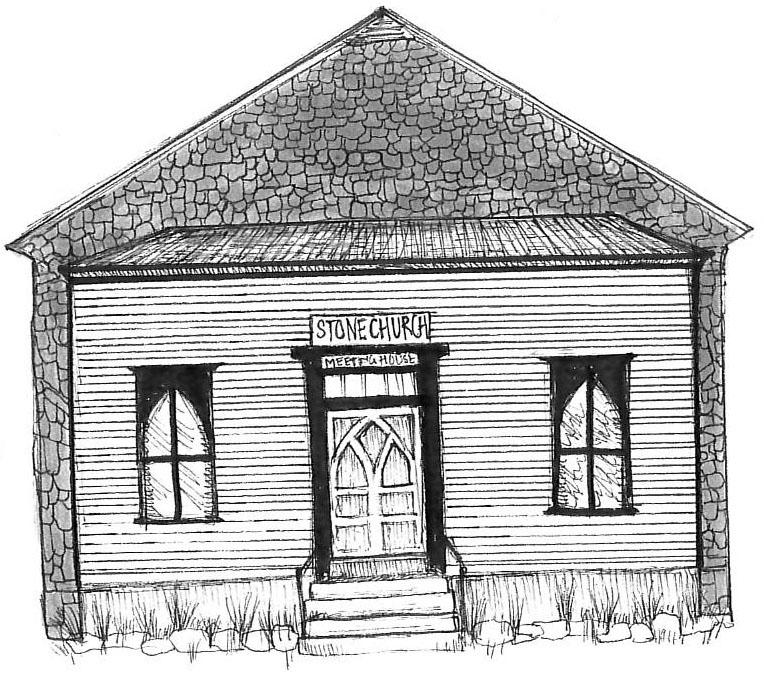
The three men, with the help of Philbrick’s brothers, spent the next few months cleaning the place up and getting it ready for opening. “We looked into the possibility of getting a beer license, which was a little difficult since none of us were 21. My mother actually stepped in and agreed to get the license in her name.” Although this seems like it would have been a concern, Philbrick explained that it never caused a real problem. “We had to be care ful carding people, especially in a college town, considering none of us were 21. It was difficult for a few years, but then we grew into it.”
Since they poured all the money they had into getting open, they didn’t have enough to advertise in a proper way. Philbrick and his friends ended up hanging some posters around the UNH cam pus. “A bunch of musicians started showing up. We had the idea to have an open mic on Sunday. If you were a musician, you could eat and drink for free. We had roast beef dinners every Sunday.” On the surface, it may have seemed that Philbrick and his friends knew what they were doing, but they were still just three college kids trying to figure out how to run a bar, and they hit some obstacles along the way.
“It was successful in that a lot of people showed up, but when I was there, we never made a penny. It was 30 cents a beer for draft beer, and we were giving so much of it away. We didn’t realize, being pretty nieve, that you still had to pay the sales tax in New Hampshire on beer you gave away. We were surprised when we got a bill sent to us from the state of New Hampshire,” Philbrick said with a laugh. Another memory Philbrick recalled related to the strict alcohol laws back in the 70s.
There’s always a discussion of the ‘forever Woodstock’ feeling, and there’s definitely a piece of that here.”
“In those days, you couldn’t walk around with a glass of beer. There was very strict laws in New Hampshire. If you wanted to move your table, you had to call a waitress to physically pick up the beer and move it to the new table. They were ‘old blue laws,’ I think they called it. It was under the assumption that if people were moving around a bar with a beer, they were going to start a fight. You couldn’t have more than one beer in front of you and you couldn’t stand up with it.”

After only a few years, Philbrick realized that he would rather be a patron of The Stone Church than an employee behind the bar. “I was doing other things. I’m a writer, and I was beginning to write novels. I found that I didn’t enjoy being a business owner. I didn’t have a very good head for it, and that was clear and ap parent to everyone else who worked there, including my partners. I liked being there but wasn’t very good at the business side.” He ended up selling his share to a Newmarket local.
Learning from the past owners, Hoffman has been working to keep what Philbrick and his buddies started and build off of it. Even before buying The Church, Hoffman and his wife had been regulars. “Cheryl [my wife] and I have been coming here since we moved here, which is like 30 years ago. I had her 40th and her 50th birthday party here, so there’s a connection. I’ve always loved the place.”
As the owner, Hoffman is determined to keep music as the main feature of The Stone Church. “The goal is to continue what it once was, and what it is, is a music club. Emphasize the music.”
What makes The Stone Church unique to Hoffman is all the incredible musicians that The Church has hosted. “What makes it special is the long history of fantastic performers [who are] way better than a small venue should be able to attract.” He continued, listing some of the notable musicians. “Dave Gerard [a musician in the band, Truffle] got his start here, and now he’s gone on to bigger places. A guy who became a national act used to hang out here. He now talks about the ‘little place on the river.’”
Gerard has been performing at The Stone Church for years now. “The first time I played there I was under age; don’t tell anyone!” Gerard said with a smile. “My very first time was one of the hoot night/dinner combos they used to do when I was 17. Just a young lad at UNH. I have been performing there ever since, with more frequency as the years went on,” he added.
Being in Truffle, Gerard has been able to perform at a lot of cool places, but he admits there’s something special about The
Stone Church. “We have played for five different sets of owners, and although different, the thing that remains the same is the vibe, history and commitment there. No TV’s to speak of, and [it’s] all about the music and whatever event they are putting on,” Gerard explained.
Gerard listed many of his favorite memories from performing at The Stone Church, one of which being when they had a beach theme and brought in sand! “Having it as a musical home when Truffle were just starting out was epic. Also, I have enjoyed many shows as a patron too,” said Gerard. Along with the more experienced, professional musicians, The Stone Church gives the opportunity for amateur musicians to have a realistic experience of performing. “It’s an opportunity for anyone to have an experience on a real stage, with a sound guy, and some lights. A lot of people that play here have never had a sound guy; they don’t even know what a monitor is. It’s a
great opportunity for people to come and share that,” explained Hoffman.
A good opportunity for any musician (amateur or profession al) to perform and try out new stuff is at The Stone Church’s Sunday open mic night, which is just one of the many events The Stone Church hosts every week. “We have music five nights a week. We have an acoustic set, which is free to the public, on Sunday afternoons starting at 4:30. That then goes into open mic night starting at 6:00. Once a month, we have a blues night on Mondays. Sometimes we do something called ‘mindful wwwMon days,’ which is sort of like a TedTalk. Tuesdays we have blue grass, which is a jam sesh for any bluegrass players to come up and perform,” Hoffman explained.
“The goal is to continue what it once was, and what it is: a music club. Emphasize the music.”
He continued going through The Stone Church’s weekly sched ule by addressing an event he is not as fond of. “Wednesdays we do trivia. I’d love to see it all come back to music. A lot of the time, we have music after trivia at like 9:30. We get a really good crowd from the UNH students. Sometimes we’ll do the same thing on Thursday nights after Irish music starting at 6. Friday nights we don’t do double shows because our dinner crowd is so big, but we do on Saturdays.”
The Stone Church is based around a good community of people looking to help each other and have a good time, which is what Hoffman and his team strive for every night. “There’s one thing about The Stone Church: it’s always going to be one of ‘those nights.’ Something’s going to break, something’s going to go wrong, but we’re gonna have fun,” Hoffman said.
He continued speaking on the locals who keep the club running. “Average night is just some amazing music. A bunch of locals... We’ve got customers here that will come four or five times in a week. Every week.”
Given that The Stone Church is open seven days a week with music (sometimes double shows) at least five days a week, money is always a topic of concern. “We lose money all week long, but the weekends pay for it,” Hoffman explained. The weekdays are slow, but the great music scene draws enough of the crowd on the weekends (Friday and Saturday nights) to break even.
To help with some of the costs, specifically for the musi cians, Hoffman and his team are discussing a membership-style system. “We’re considering something we call a ‘patron saint,’ where members can help to pay the musicians more appropri ately. Right now, we really can’t afford to pay them what they’re really worth.”
Although more money would help and allow them to pay mu sicians better, Hoffman isn’t in it for the money. “A reporter once asked me if I thought I was going to make money, and I said no. It’s not about making money anymore; it’s about having fun,” Hoffman said. “I hope not to lose money, but I think we’re gonna do okay. We’re gonna open up the second floor, which is just as big as the main floor. We’ll make it a multifunctional room.”
For the future, Hoffman is hoping to have as much music as possible at The Stone Church and keep the “forever Woodstock” feel alive. “I just want to keep [The Stone Church] going and build off of what was here before us. It was a Unitarian Universalist meeting house. They welcomed all walks of life, whatever your beliefs were. That’s what it is now. We’re a very welcoming place. We chose our rainbow welcome flag on purpose to show all are welcome. We’ve has a few same-sex weddings here, and I love it! I love that we’re a part of that.”
The Stone Church has been a rich piece of music’s history for decades, and there is no doubt it will be around for many more de cades. The great part about The Stone Church is that even though it’s a music club with a bar, it’s family friendly. “Our early shows are all ages, and after 9, they’re 21 plus, but if someone underage

wants to come, just bring a parent or guardian who’s going to be watching you.” Hoffman continued, “If you came on a Thursday night, you’d see how many little kids are running around. Last week, we had a 12 month old and a 16 month old running around together.”
The Stone Church is a place anyone can have a good time, no matter: age, gender, or beliefs. Hoffman ended reiterating on this statement. “The vibe here is just good energy. I find a lot of more experienced musicians pulling up younger musicians onto the stage. It’s a brotherhood/sisterhood thing, people wanting to take care of each other. It’s very helpful. There’s always a discussion of the ‘forever woodstock’ feeling, and there’s definitely a piece of that here.”
“There’s one thing about The Stone Church: it’s always going to be one of ‘those nights.’ Something’s going to break, something’s going to go wrong, but we’re gonna have fun.”
As another school year winds down, another batch of seniors are committing to colleges to play DI, DII, and DIII athletics. Oyster River High School has always had its fair share of commits, and this year is no exception. Notably, baseball standout Brennen Oxford (P/OF), received national attention for pitching four consecutive no-hitters during the 2017 season. He will be attending Wake Forest University in the fall. This article will highlight five other standout athletes will be playing at the collegiate level. Learn about some of these other student-athletes below!
Max Stenslie will be running DI track and cross country at Quinnipiac University this fall. Stenslie started running during his freshman year of high school. Originally, he joined the cross coun try and winter track teams as a way to get into shape for lacrosse season. However, he eventually decided to stick to running full time. He said, “once I got into it I realized that I really liked it and wanted to really put more effort into it, so it became my number one sport.”
Stenslie has had some important influences in the past four years of running, including his sister, who got him into running in the first place, his friends and training partners Parker Spinney (‘18) and Patrick O’Brien (‘17), and the ORHS boys cross country coach Scott McGrath.
As far as the recruitment process went, Stenslie began receiving letters from colleges, and several messages from different coaches. He said, “As the process went on, I kept in touch with the [Quin nipiac] coach and the Wheaton coach. And I’d email them videos from my races, I’d talk to them about my training, how it was going and everything.”

For Stenslie, it came down to running at Wheaton College or Quinnipiac University. He said, “I visited them a couple times and it came down to the campus and the programs for my major [Biolo gy] and it ultimately came down to Quinnipiac.”
Samantha Goodstein will be playing DIII field hockey at Nichols College in Dudley, Massachusetts. She first grew interested in the sport in middle school, when a friend of hers encouraged her to try it out. She’s been playing ever since, attending an overnight field hockey camp at UNH in the summer, and participating in a club called Hockey Mates.
During her junior year, Goodstein lived in South Carolina, which caused some difficulty in playing the sport she loves. She said, “ I wasn’t able to participate and be a part of the Oyster River team and for awhile I had doubts that I wasn’t going to continue field hockey due to the fact that the sport wasn’t really big down south so it was basically unavailable for me. I wasn’t able to really reach out or look at colleges during that time specifically for field hockey.” She noted that while she started the college recruitment process a bit later than usual, she and the coach have talked and she will be walking onto the team this fall.
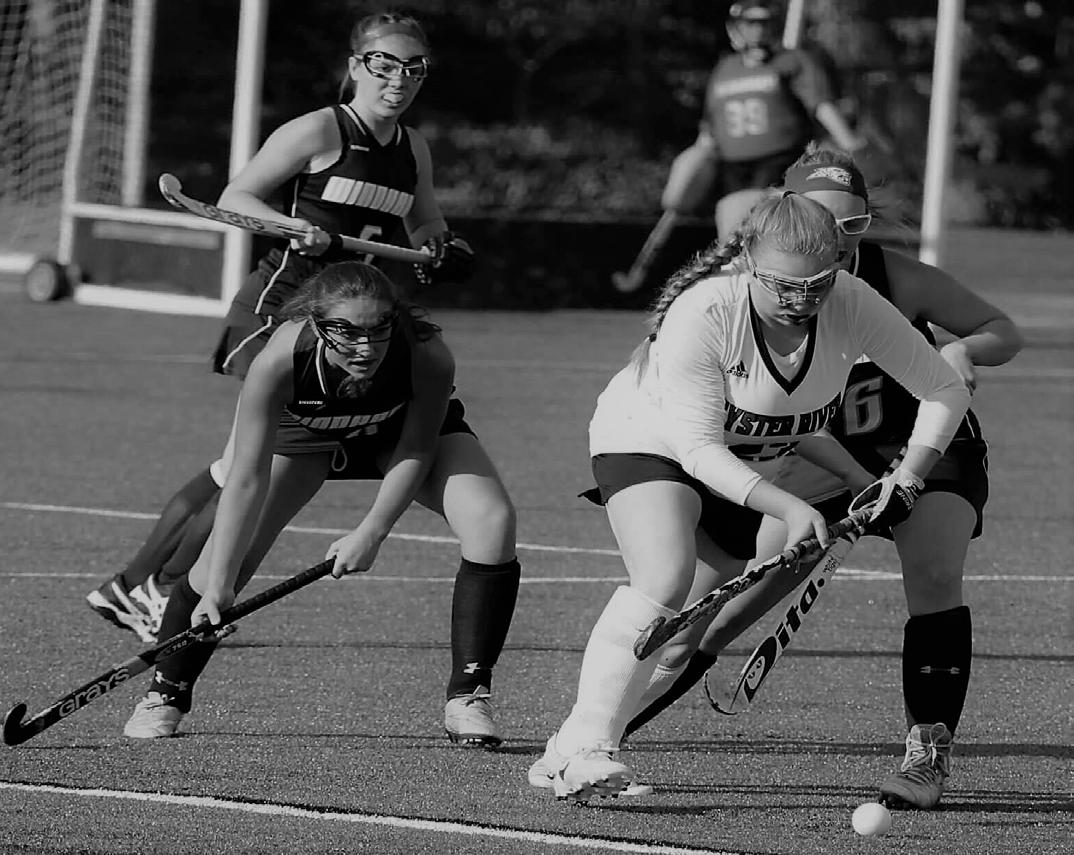
Goodstein is excited to play her sport at a higher level. She said, “I will admit I am nervous about the whole thing; it kind of feels unreal that I will be in a whole new environment with many different people, a different team that I don’t know anything about but I know that it’ll be a good experience. I will get to learn more about the sport in a higher lev el, the strengths and weaknesses among the team, and help build myself and the team to become better in every aspect.”
She went on to say that the most influential person in her field hockey career thus far has been her coach, Anne Golding. “She has pushed me to my limits and out of my comfort zone, she has taught me what it is to be a leader on and off the field, how to grow and learn from mistakes, and how to improve myself as a person and a player,” she stated.
Kieran Murphy will be running DII track and cross country at Southern New Hampshire University this fall. Rather new to the sport, having started running his junior year, Murphy quickly became a stand out at his high school in Chicago, Illinois. His family made the move to Durham for his senior year, and he joined the cross country team.
He discussed the move, saying, “it was tough to choose colleges being new to the area. I had to rethink everything after moving from Chicago. I interacted with coaches for several institutions not long after applying. It was a great experience, each coach is truly invested in [the] future and wants the best for you. It made making my college choice very difficult.”
Murphy is excited to run in college, and noted that SNHU often does workouts at Derryfield Park, a high school cross country course in Man chester. He stated, “It is the toughest course I have ever raced on.”

While pretty new to the sport, it runs in the family. Murphy’s father is a longtime runner, and his sister also runs varsity cross country; she was the one who got him into the sport in the first place. Of his father he said, “we still do all of our long runs together each weekend and have a great but painful time on roads and trails.”
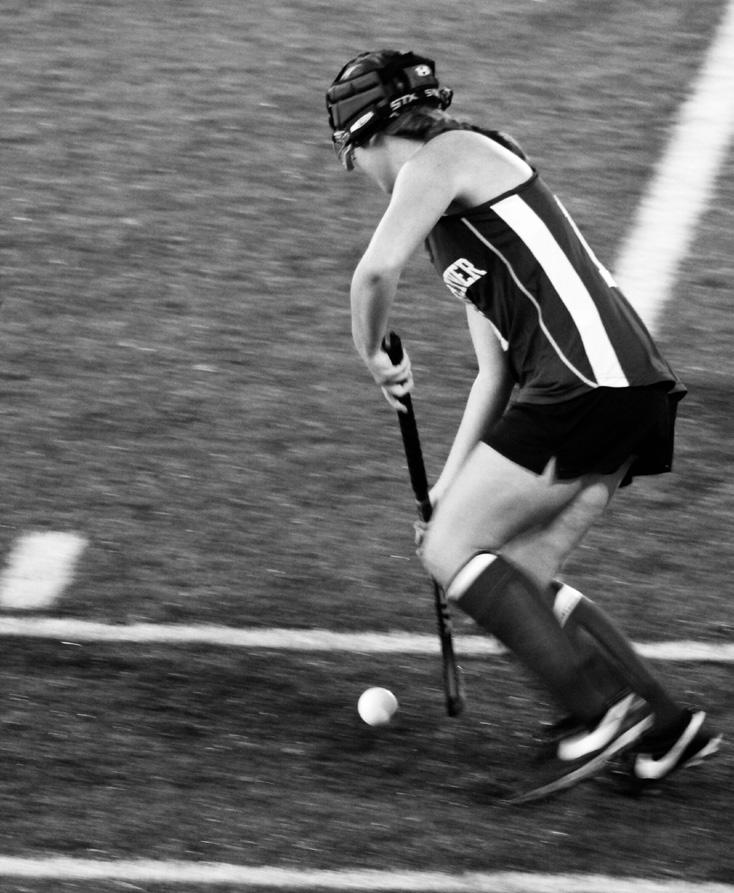
will be playing DIII tennis and field hockey at St. Lawrence University this fall. Croot began playing field hockey in fourth grade and ten nis when she was seven. She has also played ice hockey since she was four, but doesn’t plan on continuing with it in college. Having moved around a lot, she has been a part of many different programs.
Croot shared that the recruitment process has been going pretty well. She stated, “I joined something called NSTA which is a field hockey recruitment website and I got websites from colleges all over the country and my tennis coach reached out to other tennis coaches and I’ve gotten recruitment emails and interviews from them.”
She continued on to say, “I’ve played both of those [sports] and I don’t want to give up one, the teams there seems like I would fit in well.” She shared that she’s excited for a more serious level of her sports in college. She said, “I look forward to that intensity.”
Croot went on to describe her biggest sports-related influence. She said that one of her hockey coaches has really helped her. “I just look at almost all ath letes and see how much commitment they have for their sport and I just love their motivation and their drive and I always try to aspire to be as intense.”

Tyler McKenna will be playing DIII baseball at St. Joseph’s College of Maine. After visiting several local campuses, including Wheaton College and Salve Regina University, he settled on St. Joe’s. He said, “I ultimately wound up picking St. Joe’s because of the atmosphere there and the really competitive baseball program. And, they had a great program for my major, Criminal Justice.”
He stated, “I’ve played for as long as I can remember, way back to t-ball, Little League and stuff, and I play for the high school team and I play travel ball during the summer for Seacoast United.” McKenna plays second base and shortstop.
As someone involved in the sport from an incredibly early age, McKenna has had a lot of positive influences and role models for the sport throughout his life. He said, “I would say my biggest influence in baseball is my Seacoast coach, Scott Dubben; he’s the man. And my parents, they’re awesome, super supportive and they always come to all my games.”
McKenna stated that he’s excited to play baseball at the next level. “[I’m excited for] the higher level of baseball, better competition and making some new friends at school,” he said. When asked about future goals, he stated, “I want to have my number retired at St. Joe’s [when I graduate].”
“Best Buddies makes a more inclusive environment for people both with and without intellectual and developmental disabilities, and it also creates a vibe throughout the school that is accepting and inclusive to all sorts of people,” said the Best Buddies Club President, Joe Morrell (‘20).
This year at Oyster River High School, a Best Buddies pro gram, which serves to limit the social, physical, and economic separation of the people with intellectual and developmental disabilities (IDD), was created. Although the group only start ed this year, a great amount has already been accomplished from simply meeting as a group to participating in national campaigns. The program has helped to make more friendships and create a more inclusive atmosphere at Oyster River.
After a group of parents in the district dis covered this organization and addressed the school about launching the club at Oyster River, discus sion about the development of Best Buddies started. Following this, Kimber ly Wolph, the ORHS nurse, was willing to advise the group.
Along with Wolph, School Psychologist Ryan Long and the Director of Special Education Misty Lowe were also willing to lead the group and see how the program would benefit Oyster River.
Wolph mentioned that she was eager to start the program because, “everyone deserves that opportunity to have a great bond with someone and no matter what grade or if the indi vidual has an intellectual or developmental disability, everyone deserves to have a buddy to count on.”
disabilities (IDD).
Wolph also noted that, “the biggest goal when starting Best Buddies was to promote a strong bond between the member and their best buddy.”
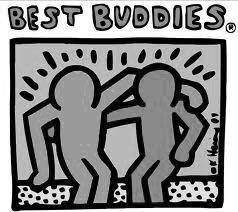
Lauren Reid (‘19), the Best Buddies Club Vice President, noted that this goal has already been fulfilled as she and her best buddy, Heather Ferguson (‘19), have a strong friendship. Reid mentioned that, “meeting at least once outside of school each month helps me and my buddy, as well as the other buddies, to have a one-to-one friendship, and form a sense of comfort.”
Along with Reid, several of the other twenty-eight mem bers that are a part of Best Buddies have established positive connections with their best buddy.
Morrell men tioned that being in contact with his best buddy, Tinu Afolayan (‘20), is not a hard task to accomplish because of how enjoyable it is.
Morrell noted that he sees Afolayan four to five times a week, and hangs out with him two or three times a month.
Some of the activities the Best Buddies pairs do are play board games or sports games, go to the movies, go to muse ums, or do each other’s hair.
With these relationships come several benefits, including a more inclusive environment and comfort for those with in tellectual and developmental disabilities. Reid emphasized this idea and said, “for the kids with an intellectual or developmen tal disability, it can be hard to connect with others and make friends. With Best Buddies, there are fun monthly meetings that help build a sense of community and belonging.”
Along with this, the Best Buddies program has improved
A newly-formed club that fosters friendships between individiauls with and without intellectual and developmental
“Everyone deserves that opportunity to have a great bond with someone and no matter what grade or if the individual has an intellectual or developmental disability, everyone deserves to have a buddy to count on.”
the atmosphere and culture at Oyster River. Morrell mentioned that, “Best Buddies has helped to create an environment where inclusion is more prominent and where the idea of friendship and fostering opportunities for people who may not be present ed with as many in their everyday life is spread.”
Not only has the Best Buddies program made a positive impact within the school district, but throughout the commu nity and nation as well. As a whole, Best Buddies is the world’s largest international non profit organization dedicated to creating a global volunteer movement that creates opportuni ties for one-to-one friendships, inte grated employment, and leadership development for individuals with intellectual and developmental disabilities.

At ORHS, the Best Buddies program took part in the na tionwide campaign, Spread the Word to End the Word, during the month of March, which was a movement to stop the use of the “R” word in society. For this campaign, Best Buddies made an effort to get every student at Oyster River to write
“I pledge,” meaning “I pledge to stop using the ‘R’ word,” on a piece of paper. The group then created a paper chain out of all of the pledges and hung it on the back wall of the cafeteria for students to see.
Recently, the Best Buddies program participated in and fund raised for the New Hampshire Friendship Walk held in Concord on May 12th. The club raised over $3,500 for the event and was ranked number one for donations in the state of New Hamp shire. The program worked hard to maintain that title until the walk took place.
Along with activ ities such as these, the Best Buddies program is looking to participate in more nationwide movements and fundraisers. The program is also eager to expand in numbers, which is something that will be easy to accomplish, according to Morrell.
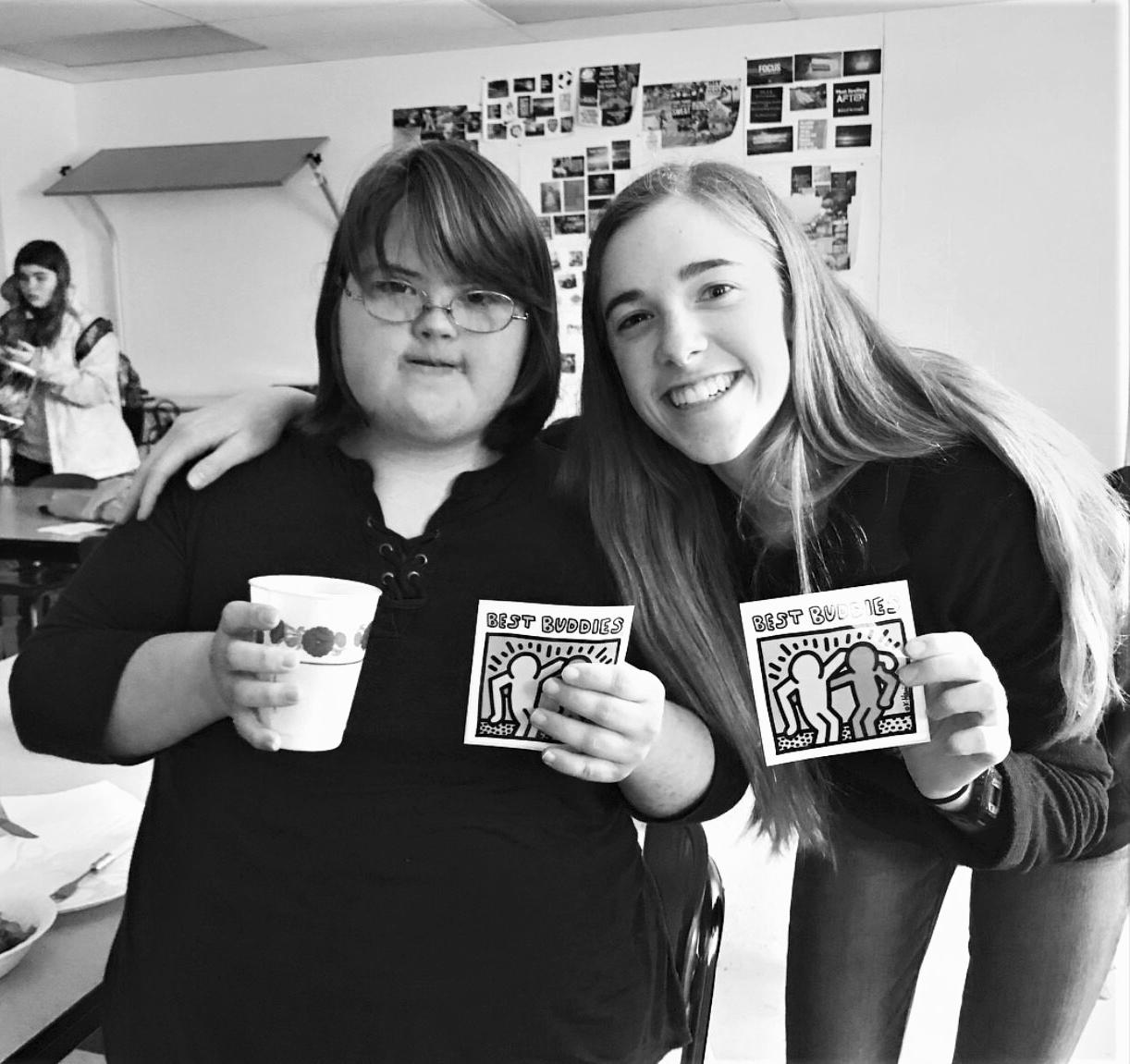
“Even though we have just started [the program], we have already gained a lot of traction in terms of interest, and I feel like the club will grow exponentially in the near future,” said Morrell.
with Best Buddies, contact or talk to Kim Wolph or Joe Morrell.
If you are interested in joining or getting involved- Abby Schmitt Photos by Joe Morrell & Lauren Reid
“Even though we have just started [the program], we have already gained a lot of traction in terms of interest, and I feel like the club will grow exponentially.”

Some of Oyster River’s most talented individuals can be found hidden away within the art room. These students is often kept out of the magazine’s spotlight, though many of their works have appeared numerous times in MOR. Read on to learn more about two of the talented artists right here at ORHS! Be sure to check out mor.news to see two more profiles on artists!
You’ve probably seen Kovalcik’s art in past MOR issues. This year specifically, she has drawn for multiple articles in each issue. Koval cik has been drawing since she could hold a pencil, but her art really took off a few years ago when she drew for a musician at ORHS. “Things really picked up for me when I did Max’s [Lufty’s] album cover, and that’s when [MOR] started coming to me for drawings.”
Kovalcik first got into art because of her older siblings’ influence. “I have three older sisters, who are all into art. I’m a lot younger than them, so I would always try to emulate them; I would wear their clothes and do what they did. Then, I started getting into [art] more and more. I think I always wanted to not only be like them, but be better than them. I wanted to prove myself.” She certainly has proven herself over the years. And with her years as an artist, her style has changed and evolved. “I’m pretty adaptable, but I don’t like to make things too real. You can never get perfection or make some thing exactly as it is, so you have to stylize a little bit.”
Specifically for her work in MOR, Kovalcik has worked on simpli fying her designs. “For the MOR drawings, I don’t have weeks to do them, so you have to simplify it. I enjoy simplifying things, especially with a lot of my new stuff. I’m really getting down to the lines, and I’m enjoying that.”
As a junior, Kovalcik has been thinking about her future, which she isn’t sure about yet, but she knows it will involve art. “I really want to find a way to incorporate [art] into my daily life. I’m not sure what that’s going to be. Everyone always asks me if I want to go to art school, and I always say: ‘I really like to eat.’ I don’t want to be the stereotypical starving artist. I want to be able to successfully incorporate it into my life.” She has taken a practical approach with her goals, in hopes of combining passions to be able to do what she loves.
“I have been looking into product design, like creating things we use in everyday life to make them more efficient and nicer looking. I always have a vision in my head about what things will look like.”
Kovalcik always works to make sure she is standing out in the art world, which is where her signature came from. “I label all my art as Emmko. In the art world, you have to stand out to a certain extent; you can’t just be run of the mill, because then you’d be just like everyone else. Anybody can paint or draw if they really work at it, but if you want to set yourself apart, you have to [stand out]. Emma is literally one of the most common names in the world. I was always so frustrated with my mom that she named me Emma. My cousin, Becky, comes from Slovakia, and her brother’s name is Christian, but they call him ‘Kiko,’ and so I thought I could do something similar. It’s the first two letters of last name, so it sounds pretty different. I always sign my art ‘Emmko.’”
Drawing for MOR allows Kovalcik to create lots of different things from grocery produce to smart speakers, but her favorite thing to draw is portraits. “I love to draw faces. I started drawing portraits of my friends, which was scary, because I never wanted to show them. I got into this abstract thing where you could draw a face and it wouldn’t have to look like anyone’s face. You can do it how you want, and it’s correct. That’s what I really like about it.” She closed with what she loves most about art: “I love how inventive I can be. Nothing is wrong or right, it’s just a grey area full of possi bilities.”
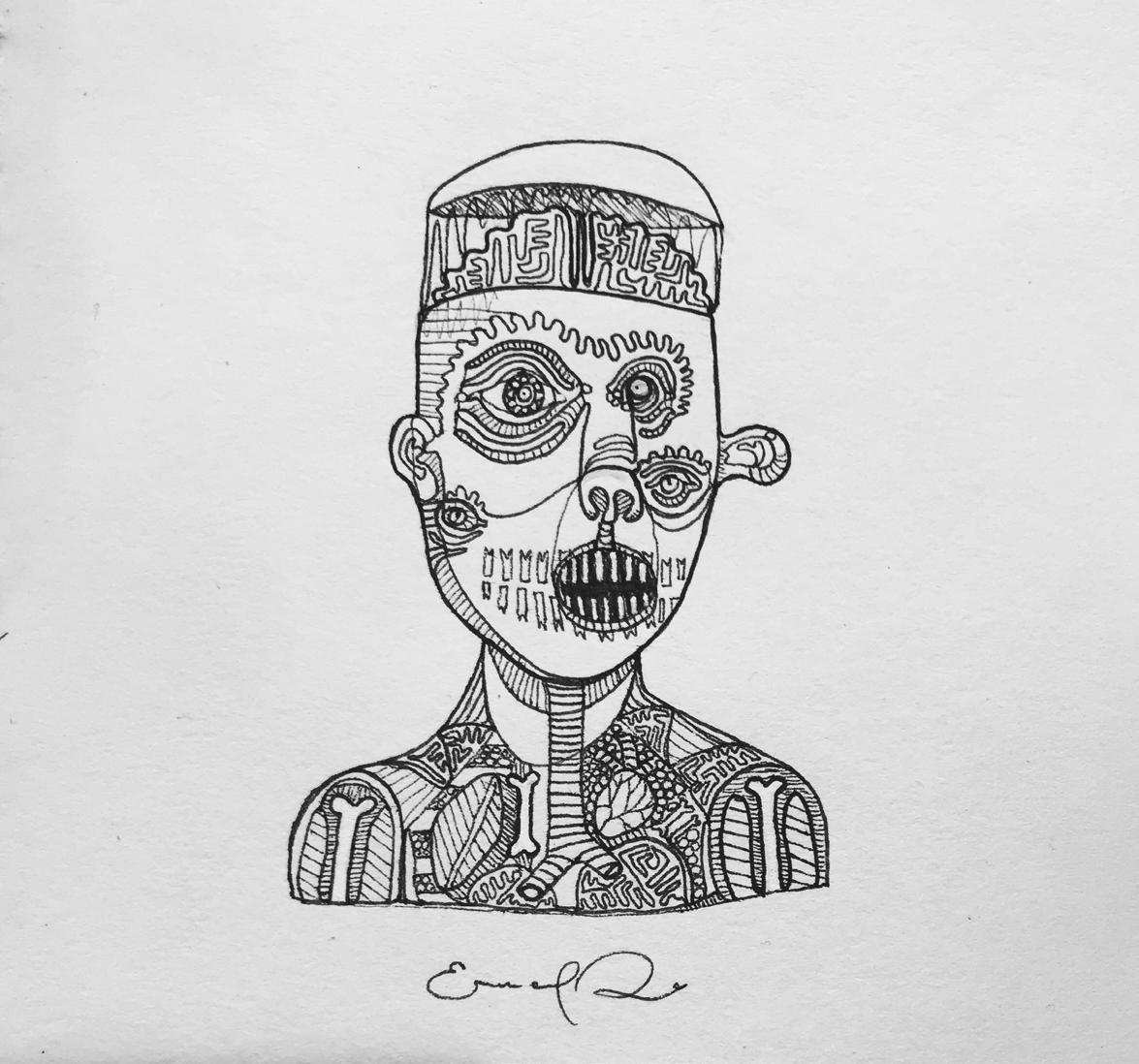
Along with being a great artist at the high school, Albert also has also been a musician since preschool, involved in the school’s theatre productions, and a budding photographer. “I’ve always loved drawing. Ever since I could figure out how to use a pen I’ve been doodling,” said Albert, a junior at ORHS.
Albert has a very specific style of art that she prefers over others. “I absolutely LOVE drawing realistic drawings. Since the end of sophomore year I’ve been working on drawing hyper realistically. Anything that I can look at from a photo and paint or draw, I usually enjoy drawing. However, I do plan to work on incorporating some graffiti and abstract effects to my realism art soon.” Albert has more recently found her voice as an artist and has been experimenting with many styles to see what she loves and is best at.
Like Kovalcik, Albert has been using her social media as an easy outlet to display her art. With being in the art classes, a lot of her work has been hung up on the walls of the school.
Compared to others, Albert is more unsure of how far her art will take her into her future. “I don’t know how far I want to take my art passion. I definitely won’t let it die, but I fear that making my outlet in life my career, it’ll feel like work. I might try to incorporate art into my career, but as of right now, I don’t want to make it my career.” Albert wants to make sure her art is always something she enjoys and not something she dreads doing. Similar to Phofo los, Albert uses art as a way to relieve stress.


“Any form of art is like a stress outlet to me. You can’t go wrong with art; that doesn’t mean that I don’t have drawings or paintings that I strongly dislike. I’ll sometimes draw one photo three times before I end up liking one. That’s why I don’t create multiple drawings within a span of two days or so.”
Albert ended by talking about her father who has been her inspiration since she was a little girl. “I remember as a kid I started out by coloring in my dad’s drawings that he would draw for us. He used to draw horses and other animals and I’d get so excited when he’d give us one to color in. Even though my dad is a mechanical engineer, he’s al ways been my inspiration. He’s the one who got me into art. I’ve always looked up to him for guidance; I doubt I’d be the artist I am today if it weren’t for him,” Albert said. She explained she doesn’t have a famous artist that she looks up to, “only because I feel like every artist has their own style, and if I strived to paint like a famous artist, I’d be striving to paint something that isn’t my style.”
Of course there are so many more artists at ORHS than these students, and the two others mentioned on our website, but this was just a look into what wonderful, creative people we have right here in our community. If you’re interested to learn more about these artists, follow them on Instagram!
Emma Kovalcik: @emm_ko
Gabbe Albert: @gabbe.albert
Hamilton Photos and Artwork by the featured artists
Every four years, the world’s most popular event captures the planet for a month. Another FIFA World Cup is upon us, and with the United States embarrassingly failing to qualify, many Americans are struggling to find a team to support. However, with such a diverse set of nations, characters, and play styles to choose from, this guide is here to help you pick the country that you’ll root for this summer.
A favorite: You can expect your team to make a deep run
A bubble team: Your team has an outside shot to win it all, but could make some noise
An underdog: Your team has a relatively small chance to make it out of their group
A longshot: You want to support this team because you feel bad for them
You enjoy watching timely build-up play, and like to see your team dominate possession
Germany (Favorite) - The defending champions will look to become the first back-to-back champions since Brazil in 1962, and their well round ed, powerful roster may be the most complete in the tournament.
Spain (Favorite) - As consistent as they come, you can expect Spain to keep possession for long strings of time, sometimes to a fault.
Croatia (Bubble Team) - The Croa tians boast one of the tournament’s strongest midfielders, featuring Luka Modric and Ivan Rakitic, but a comparatively weak group of attacking talent could make things difficult if they can make it out of their group.
You need to have faith that your team will put their bodies on the line for World Cup glory
Russia (Bubble Team) - The host nation always gets an automat ic bid into the tournament and therefore Russia didn’t have to play qualification matches, so this untested and low-profile group of players will look to surprise to teams with their physical and defensive style.
Australia (Underdog) - Through out qualifying, the Australians played a bizzare 3-4-1-2 formation that often isolates their attacking players, and squeezed out some close results to qualify.
Tunisia (Longshot) - The name of the game for Tunisia is hard work, and their lack of skill was made up for by relentless pressure in the qualifying rounds.
Group A Eygpt Russia Saudi Arabia Uruguay
Group B Iran Morocco Portugal Spain
Group C Australia Denmark France Peru
Group D Argenta Croatia Iceland Nigeria
Group E Brazil Costa Rica Serbia Switzerland
Group F Germany South Korea Mexico Sweden
Group G Belgium England Panama Tunisia
Group H Colombia Japan Poland Senegal
*If you don’t understand what the groups mean, see ‘Know the Format’
You want to support the team with the fastest group of play ers, regardless of soccer skill
England (Favorite) - A direct and quick team, often inconsistent but thoroughly exciting.
Switzerland (Bubble Team) - Swit zerland’s lack of star power makes them a tough pick to make a deep run, but their direct and creative play can lead to goals in a hurry.
Japan (Underdog) - A controversial new manager has changed the na tion’s traditional passing system and given minimal playing time to some of Japan’s most well-known stars, but they still managed to qualify among the top Asian teams.
Nigeria (Underdog) - Never afraid to attack, the Nigerians are known to push their defenders forward and use width in their pursuit of goals, but this attacking mentality can backfire on the other end.
Iran (Underdog) - Iran doesn’t nec essarily have the fastest players, but a new manager has implemented a quick style with an offensive edge, which payed off for the Iranians in qualifying.
Saudi Arabia (Longshot) - The Sau dis play a fast but undisciplined style that stronger teams will be able to exploit if they’re not careful.
Regardless of the level of the overall squad, you just want to see one player that sticks out above his teammates
Argentina (Favorite) - Al though he has strong attack ing talent around him, it’s on Lionel Messi to deliver for 2014’s runner-ups.
Portugal (Favorite)The reigning Euro 2016 champions were able to take home the world’s second-biggest tournament despite Cristiano Ronaldo struggling with injury. A healthy Ronaldo makes them a threat to anyone.
Uruguay (Bubble Team) - Be yond superstar strikers Luis Suárez and Edinson Cavani, Uruguay doesn’t have a supporting cast that can make them a favorite, but these two could make things very interesting as the tournament progresses. (I suppose they’re actually a Two Man Show).
Poland (Bubble Team)Goal-scoring machine Robert Lewandowski is the only thing that keeps the team in the bubble category; the Polish will rely on him to produce at his best if they are to make a deep run.
Denmark (Bubble Team) - After missing out on 2014’s World Cup, the Christian Eriksen led Danes return to the world stage after a surprisingly productive qualifying campaign.
Senegal (Underdog) - Sadio Mane leads a quick attacking line that will look to get behind defenses at any opportunity, but his team mates will rely on him to do most of the scoring.
South Korea (Longshot) - Ques tions can be asked about the entire squad except for top scorer Heung Min Son, who will have to do much of the work on his own if the Koreans are to pick up any results in their group.
You may think soccer can get a bit dry at times, but cheeky skills and long range shots are worth watching
Brazil (Favorite) - Always among the most entertaining squads, the Neymar-led Bra zilians are sure to be in their opponent’s half for most of the game.
France (Favorite) - Their out rageous talent, led by super stars Antoine Griezmann and Paul Pogba, makes France an intriguing squad to follow, but they’ve had trouble producing results in major tournaments recently.
Belgium (Favorite) - On paper, Belgium has among the best rosters in the entire tourna ment, but this relatively young team has a lack of late round experience and has yet to per form up to their hype.
Colombia (Bubble Team)James Rodriguez made a name for himself by leading the Colombians to a surprising quarter-final finish in the last World Cup, but questions of the nation’s consistency and depth limit their chances to make a deep run.
Mexico (Bubble Team) - The Mexicans completely domi nated North American quali fying, but could have trouble using their ultra-attacking style against stronger compe tition.
Morocco (Underdog) - The Moroccans will look to play through their skillful midfield players and at times try to dic tate the pace of play, but their overall squad doesn’t have the quality of many other teams in the tournament.
You drool at the idea of consistent, traditional defensive soccer
Sweden (Bubble Team) - Zlatan Ibrahimovic recently an nounced that he will not return from international retirement to play in the World Cup, but the Swedes have proved that they belong after knocking out Italy in qualifying to claim a spot in the tournament.
Iceland (Underdog)- This tiny island nation shocked the continent when they made it to the quarter-final stage of Euro 2016, and have since become the smallest nation ever to make the World Cup.
You don’t want your team to stick to one style, every game can be a surprise
Serbia (Bubble Team) - It often seems like Serbia plays not to lose more often than they do to win, but strong de fensive play is valuable when facing increasingly difficult competition.
Egypt (Underdog) - Although also a one man show with winger Mohamed Salah as their only attacking weap on, you can expect Egypt to sit back and defend for a large majority of the game and then try to squeak out low-scoring wins.
low-scoring wins.
Panama (Longshot) - Panama snuck into the World Cup thanks to an abysmal American display against weaker teams, and at this point are just happy to be there.
to be there.
Know the Format: Each team makes the tournament by finish ing among the top teams in their continental qualifying round. Then, they are semi-randomly chosen in to eight groups of four, which are systematically supposed to be as even as pos sible. Group play is round robin style, and the two top teams qualify for the round of 16, where they will play top teams from other groups. The tournament is single elimation from there on out.
Now that you’ve picked your team, it’s time for you to get pre pared to support them this summer! If you’re already a big-time professional soccer aficionado, you can brag to your friends about all the reasons why your acquired team will perform better than theirs. If you’re new to this whole ‘international soccer’ thing, take a few minutes online to study up on your country, and then impress your friends with your depth of knowledge. Additional ly, make sure you check your team’s schedule and clear yours if needed. Best of luck!
-Zach LeichtmanI love sports, and I love being a member of a team more than anything. I’ve made so many friends because of sports and looking back, I don’t regret any sport I’ve tried; soccer, hockey, lacrosse, and track. I have played “right bench” or “left bench” and even “center bench” during seasons, but I still enjoyed every second of it. I’m not the best athlete out there (quite bad at most sports), but I try my best in everything I do. In my opinion, no one should become discouraged when it comes to playing time in sports at the high school level.

On any sports team, there are always more players than the amount needed to field a team, yet most fans only focus on the starters. It’s important to realize that there’s more to a team than the starting line up. Everyone shows up, everyone works hard, and everyone works together. I have a lot of experience when it comes to “playing” the bench, and it has taught me how important being a team player really is. Supporting one another and hard work are the backbones of a team, no matter if you are on or off the field.
“A team is more than one person, so anyone playing in the game directly affects the team’s season. The people who don’t play are trying to get playing time, and end up pushing everyone around them to work harder in order to keep the playing time they have. There are so many inner workings of a team that rely on more that just the best player,” explains Quinn Wilson (‘19), boys’ varsity swing soccer player.
Sitting on the bench doesn’t necessarily mean you’re bad, it means you need to improve more in order to earn your position. But while earning it, you are continuously displaying qualities of a team player. “I think that everyone on the team matters if
they put in the same amount of time and effort, sitting on the bench for the soccer team helps me motivate myself so the coach will notice that I should go in every once in awhile,” explains Annie Wardwell (‘19), girls’ varsity soccer player.
On occasion I do have frustration, but over time I’ve made the best of it. My teammates and I always joke around about it, and I’m never afraid to say “catch me playing right bench in Friday’s game.” Yes, I love playing time, but I also love the teams I’m a member of. Therefore many negatives that can pop up in a team environment, I try to turn into positives for me. “You can still add and bring a great energy to a team just from being on the bench. You also need fans and if you are at a far away game, and not many fans came to cheer you on, you can always count on the bench,” says Vivian Keegan (‘19), girls’ varsity soccer player.
“Throughout my years of sitting on the bench I believe it had made me many friendships, that I may not have had if I was playing,” added Keegan.
My best advice for those who are frustrated with the amount of playing time, is to work for it. If you are always put ting your best foot forward, you aren’t only doing it for you, but
for the rest of the team. Pushing yourself influences others to do the same. Even if you don’t reach your goal, you can have more fun working hard than sitting and being sad about your current position.
Sometimes it’s difficult to watch your teammates work hard, knowing you want to go out there and show everyone you’ve worked just as hard. There are some games, where I so badly want to go in and make a huge play. “I have been frustrated about playing time but no one really changed my mindset. I just think it’s for a good reason and the better of the team, so I’m not going to let it affect the environment and I will keep working hard,” says Ben Clement (‘18). Clement has had times where his amount of
playing time upsets him, yet he is nothing but a positive teammate to his peers.
Understanding where and how you can improve is the key to improvement. It’s easy to turn your time on the bench into a positive experience. “The more positive energy and positive in teractions with teammates makes them enjoy the game more. And people succeed more at things they have fun and enjoy doing,” says Sadie McKenna (‘21), varsity tennis player. No matter what position you play, you can still be a huge part of the team envi ronment. By sitting the bench, it made playing time way more valuable for me than it was for others.
No matter if you’re a freshman, a sophomore, a junior, or a senior, it’s so easy to be upset or angry about not getting the playing time you wished to have. Yet thinking about the bigger picture, it may be one game, one season, or multiple in a lifetime full of wins and losses. You’re a member of the team for a reason, and you’re there to make the best of it. I don’t get down about myself, and sports have been one of my favorite aspects of high school. “There’s always going to be a large group of players that are good but don’t play. I think the best advice is to know that not being the best is okay and that this lesson can apply in real life,” explains Keegan.
 -Felicia Drysdale Photos By Kristen Carpenter and Arleen Alphonse
-Felicia Drysdale Photos By Kristen Carpenter and Arleen Alphonse
There were roughly 870,000 divorces within the United States in 2016. This data, according to the Centers for Disease Control and Prevention’s “National Marriage and Divorce Rate Trends” annual study, also raised the country’s percentage of divorce within the first five years of marriage to fifty-three, the highest it’s ever been recorded.
Though those numbers may seem daunting, they are just some of the many statistics floating around about divorce. However, in the experiences of many, watching two parents separate holds much more meaning than the numbers. Each and every situation varies completely, and while some common themes often arise from a divorce, talking to oth ers who have seen it happen first-hand has made me realize the dangers of assuming any sort of generalizations.
I also know these things to be true because my parents got divorced during the summer going into my sixth grade year. My story started when I had come from a vacation with friends to discover half of the furniture missing from my house and a completely unforeseen explanation from my parents that they just weren’t happy anymore. At the time, none of my friends had divorced parents and didn’t really seem to understand what I was going through.
Since then, I’ve learned a lot. Things haven’t always been easy, but I can’t imagine my life any differently than the way it is today. It’s for this reason that I wanted to share my experiences, in hopes I can shed light on what one of the thousands of potential divorce situations has taught me.
Being an only child at the time of my parents’ separation, I was pretty isolated when it came to people that were in the same position as I was. This was amplified by the fact that I moved towns and changed schools that same year, transfer ring from the private, Montessori style of education I was used to, into Oyster River’s public model. I went from being the only kid in my entire grade to being one of nearly one hundred and eighty, all while trying to navigate living in not one, but two new houses.
Because my parents realized that this was a lot to put on the shoulders of an eleven-year-old, they sent me to ther apy. At first, I was extremely against this idea, and was almost embarrassed by the fact that my parents even thought I might need extra support. Looking back now, I realize just how helpful it was to have an objective ear to talk to, especially because I didn’t have any real friends at the time. Getting to vent about what was going on around me was helpful in ways I would’ve never guessed prior to therapy, and having a safe space to do that in was one of the most important parts of moving past some of the hurt I was feeling at the time.
Aside from therapy, there are several other ways to find closure through talking to others. For me, writing has also been an outlet that allows me to share things that aren’t always as comfortable to say aloud. Similarly, when I talked to other students with divorced parents, it was commonly said that activities such as sports and clubs helped them to work through their own struggles and share their feelings on the situations at hand.

1. Talking helps, no matter how cliché it sounds
The number of times I’ve been asked by friends about why I just can’t go grab something from one house when I’m at the other is almost too many to count. While the answer to this ques tion is relatively simple: because it takes a lot of time and gas to drive completely out of my way for something I can just grab in a week, there are many more questions that aren’t as straight-for ward. An example of this is pretty reoccuring, and happens almost every athletic season during team spirit.
Since many of the things teams wear to promote their games are not your run-of-the-mill, everyday items, I often do not have what people are wearing at my house. This has resulted in countless panicked midnight trips to fetch whatever dress clothes, Hawaiian button-down, or tie-dyed shirt I need for the next day, which can be frustrating when you know that many people don’t have to think twice about having all their clothes in one place.
In addition to the uncertainty about what to pack, I also struggle with how to pack. Typically, I spend around an hour and a half every week gathering clothes, shoes, school supplies, sports equipment, and other miscellaneous items I may need into various backpacks, suitcases, and bags. I then drive fifteen minutes from one house to the other, and lug everything up several flights of stairs before spending another hour or so settling back into the other house.
Even more complicated than this weekly debacle are things like taxes, paying for my car insurance, and college expenses, which my family is still trying to work out based on a variety of factors. Though even non-divorced families are trying to figure these out, it becomes more complicated when I can’t remember the last time I was even in a conversation with both my parents at the same time. It can be hard when that concept might not even be a second thought to friends, yet that’s the reality of my current situation.
Times like that are exactly when flexibility is most important. Students in similar situations agreed: they’ve come to realize that no matter how hard they look, they will still never be able to fully answer all the questions of the future. What’s most important is dealing with each challenge as it arises, and trying to make the solution fit best into unique family dynamics.
According to the Centers for Disease Control and Prevention, there were roughly 870,000 divorces in 2016, which raises the United States’ percentage of divorce within the first five years of marriage to fifty-three.
Because I am an only child, I was left alone to figure a lot of things out. However, my parents’ divorce ended up being one of the most beneficial times in my life for personal growth as a result.
Even students with siblings agreed when I talked to them about the same topics. Several shared that since everybody deals with things differently, divorce impacts no two family members in the same way. This means that learning the skills of independence is still important, as you and your sibling may not always be able to be there for each other if you disagree on certain aspects of a divorce.
Though I’m not accustomed to having siblings, I discovered the lessons I’ve learned are quite similar after talking with people who do. For example, I’m now used to spending stretches of time away from one, if not both parents, and I’m less affected by being put in unfamiliar situations. As a result, I am much more comfortable travelling alone and navigating my way through a city, all because I’ve had to learn how to speak up for myself and be more self-re liant.
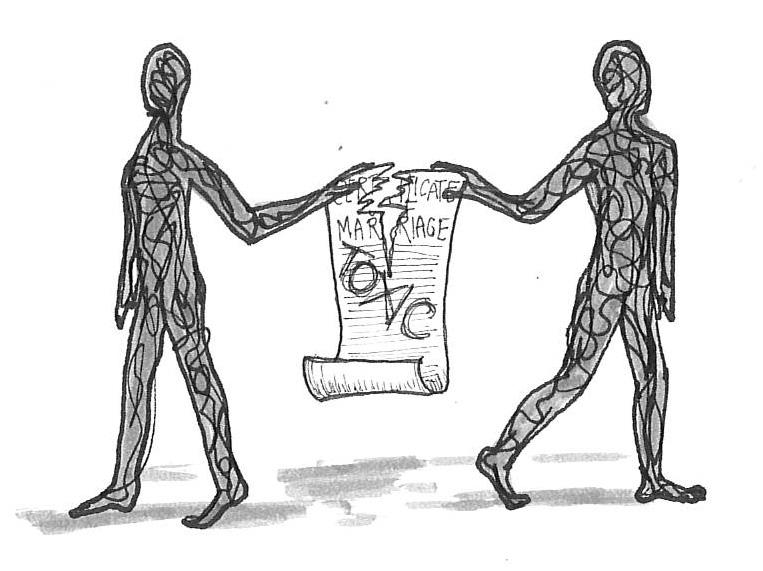
With this independence has also come a sense of confidence, which I’ve picked up from having to talk to many people about my personal experience with divorce. It comes up in conversation much more than I would’ve thought, which often leads to me explaining somewhat personal details in a way that’s still effective without getting too distracted by minor details.
Similarly, since both my parents are never around at the same time, I’ve had to learn things like more adept time management skills. This is because in a divorce, one parent often has to take on the roles of both when with their child. I found that the result of this was that my parents had less time to keep track of what I needed to do on top of whatever they needed to.
With that presence removed at an earlier age, I’ve been dealing with the combination of school work, sports, and whatever else needs to be taken care of by myself since sixth grade, which I’d like to think has made me more proficient when I have to deal with heavy work and task loads now.
2. You need to be flexible while you figure things out as you go
Of course, with every divorce, there comes the possibility for remarriage. In my family’s case, both of my parents have since gotten engaged or married, leaving me with double the amount of parents that I started with and five new step-siblings as a result.
At first, seeing my mom and dad date new people was hard for me, since it’s not always easy to let go of what you’ve been used to for so long. There were certainly plenty of awkward times, like first meeting their boyfriends or girlfriends, but with time, the awkwardness passed. I feel extremely lucky that I have a great relationship with my step-dad and soon to be step-mom, and an equally great rela tionship with their kids.
It’s actually been through spending time with my step-families that I’ve learned the most, as they see many things in a different light, which has been eye-opening.
Other students whose parents remarried after divorce seemed to agree, and shared that spending time with their newer family members has helped them to be more accepting to others. I agree with this, as getting to know a person quickly, like one often does with step-families, allows you to see that many people in the same situation are struggling in their own ways.
I’ve also come to realize that it’s also nice to have an adult in the household to turn to with things that isn’t a par ent, as their disconnect can often be helpful if I ever need brutally honest advice. In addition, having step-siblings has brought a whole new light to vacations and holidays, and I always have more fun when they tag along. It’s also very reassuring to know that they’re always there if I ever need to reach out to anyone, since they can also offer a different perspective on things as a result of our unique relationship.
On both sides, my step-siblings have also had their own experience with divorce, and hearing them share their stories and takeaways has been extremely helpful for me numerous times over the past several years. Though it’s never easy to add members to a family, I couldn’t be happier to have been able to walk away from the experience with more of an appreciation for seeing my parents happy and whole again.
As summer begins within the coming months, it will mark six years since my parents’ divorce. While I’ve learned more than I ever would’ve initially believed over those past six years, I know there’s still more to dis cover.
There are times, even now, when I still struggle with changing houses or not having both my parents close together. However, since I’ve become more comfortable with talking about how I feel, packing every week, and being independent, I feel as though my overall experience with divorce has been a positive one. Especially when I also account for the new family members and sense of flexibility that I’ve acquired.
Overall, I feel extremely lucky that my family is so open to my input on our unique situation as a whole, but I realize that not every situation has worked out exactly like my own. As I mentioned at the beginning of this article, each situation is so different when it comes to divorce, and it’s impossible to generalize such a broad topic.

While broad, I do think it’s a topic that needs to be discussed regardless. Though combining my own expe riences with an array of others’ who have seen divorce occur within their own homes, I’ve learned that no two divorces will ever be the same, or even similar. Despite this, there was a constant recurrence of things to be learned and opportunities for individual growth hidden within even the hardest of times.
-Devan McClain Artwork by Emma KovalcikClipart from Flickr
4. If your parents remarry, you’re in for some surprises

Please note that this story was written before the shooting at Santa Fe High School in Santa Fe, Texas.
February 14th began as a normal day for Carly Novell, a senior at Marjory Stoneman Douglas High School in Parkland, Florida. Until 2:20 pm, when her class was interrupted by the sound of the fire alarm. Novell recalls feeling annoyed that she would have to walk outside in the hot sun for what she thought was just a routine fire drill, but little did she know that this alarm signaled something much different. She was soon in formed that there was an active shooter in the school, and was rushed back into her classroom before eventually moving into a closet, where she waited for 90 minutes as terror unfolded around her.
Over the past few months and years, I’ve noticed that there’s a question that comes up more and more frequently in conver sation with my friends: Where would you go if there was a shooter in the school? We’ve debated whether it would be safer to hide in a classroom, or if it would make more sense to just run for our lives.
It wasn’t until recently that I realized that this is not normal. It is not normal for 17 and 18 year olds to be worrying about their safety in their place of education. It is not normal that I sit in class on a daily basis, examining the room to search for hiding places and escape routes. But for my generation, one that has lived through the killing of 20 children in an elementary school, and 14 teenagers at a high school, as well as countless others, these thoughts feel necessary. If it can happen in Newtown or Parkland, it can happen anywhere.
It has been over five years since a gunman opened fire at San dy Hook elementary school in Newtown, Connecticut, and not a single piece of federal legislation has passed that could prevent events like these from happening again. After the tragedy in Parkland earlier this year, when all that politicians could seem to provide were their “thoughts and prayers,” it was evident that federal gun legislation was unlikely once again. But there was something different about this instance than the ones prior. In the past, we have, for the most part, accepted that nothing would change, and then moved on with our lives until the next tragedy struck, and the cycle would then repeat. This time, the stu dents from Marjory Stoneman Douglas High School channeled their anger and dissatisfaction, and have changed the national conversation around gun control. They’ve made impassioned speeches that are quickly going viral, they’ve stood face to face with politicians and have called them out on their lack of action, and most notably, they planned a march in Washington, DC that drew in a crowd of roughly 200,000 people.
Novell is hopeful that the actions of her classmates and other young people throughout the country will eventually lead to the passing of federal gun control legislation. “This movement is actually showing our country the issues with our lax gun laws,” she says. “If everyone sees those issues, then something has to change.”
I’m hopeful that this movement will keep up its momentum and will remain in the national conversation. As the days and months pass after the tragedy in Parkland, we could easily
become removed from the situation, and forget how angry and upset we were that day. If we lose track of how important this issue is, then we won’t be reminded again until another tragedy strikes.
As a teenager, I feel that I’m constantly being sent messages that my opinion doesn’t matter, or that I’m too young to take ac tion. This is the first time in my life that I feel like this isn’t the case. When I turn on the news and see students my age speak ing to crowds of over a hundred thousand, I feel like people are finally listening to what young people have to say. It’s unfor tunate that it took a tragedy like this for that to finally happen, but it still feels rewarding to have the opinions and beliefs of my peers deemed valid by adults, who have historically shaped national conversations. Novell reiterated my sentiments, and stressed the importance of young people making their voices heard. “We are the next generation to vote and to have a say in this,” she says, “not only that, but gun violence is so prevalent in this country that it’s possible that students or their loved ones may be directly affected.”
The midterm elections are coming up this fall, and several seats in congress, along with many positions in local govern ment, are up for grabs. If you’ll be old enough to vote in No vember, be sure to research the candidates running in your state and district, and vote for the person who’s stance on gun control aligns with yours. Participating in our democracy is not only a simple way to make your voice heard, it’s also the most effective. Voting in elections is crucial in keeping up the momentum of this movement.
In the past few months, a lyric from the broadway show, Hamilton, keeps coming to mind. It says “this is not a moment, it’s a movement.” This reminds me that this drive and passion to create change can exist not just temporarily, but also on a scale so large that real change is made to the point where our grand kids will read about it in their history class someday. The time for change is now, and the young people in this country will not stop fighting until the safety of the generations that follow us is assured.
-Maisie Cook Photo by Katy Zurka
Clothes. An essential for all of us, unless you’re planning to move to a nudist colony sometime soon. What may have started as a utility for warmth and protection from the elements has now expanded into a multi-trillion dollar industry. A concept known as “fast-fashion,” or the mass-production of inexpensive ly-made clothing items to compensate for the constantly-adjust ing fashion trends, has overcome our current society. Although this mass-production may reduce the price of garments, it has also caused a dilemma: there seems to be a surplus of clothing that the world does not have space for.
Fortunately, there are ways that we can combat this issue which don’t necessarily involve going cold-turkey on clothing purchases: buying second-hand.
First and foremost, we could all stand to cut back on the number of new garments that we purchase (myself included!). For some of us, this may be diffi cult, so to ease off our excessive spending habits, try checking out some second-hand clothing stores. This way, you can contin ue to purchase clothes which are new to you, but you don’t have to worry about encouraging the sur plus disposal of clothing through supply and demand. Plus, it will help keep you from breaking the bank! Some local second-hand options include Salvation Army, Plato’s Closet, Goodwill, and Savers.
clothing is necessarily such a big deal.
Here’s the sitch: with increased usage of synthetic materials in our clothing, many garments contain elements which are toxic to our environment. Check your clothing tag! There’s a good chance that it contains a high percentage of synthetic ma terials, such as polyester, rayon, and nylon. These fabrics, when discarded, can leak toxic chemicals and dyes into waterways and surrounding soil.
Unfortunately, it doesn’t seem as though there is any end in sight to the over-production of these products. The fash ion industry is growing, and it certainly doesn’t show signs of slowing down. According to the National Public Radio article, “What Happens When Fashion Becomes Fast, Disposable And Cheap?” over the past five years, top fast-fashion retailers have grown by 9.7% each year. With this influx of production, what happens to the discarded items? While many of us hope that the answer to this question is that the excess items are donated to those in need, unfortunately, the majority of these garments do not receive this happy ending. To cut back even slightly on wasted clothes, it is important that we first look to ourselves. Go back through that extensive closet from which we claim we have “nothing to wear.” Many of us over-shop, and it’s time to combat these habits.
If you’re looking for other options to refresh your wardrobe without contributing to this epidemic, consider a clothing swap. What has now become a relatively popular trend for YouTubers, who vlog their “new” wardrobe hauls, can also work for you and your friends! Simply team up with a friend of similar size who is experiencing the same wardrobe boredom, and exchange a large portion of clothing items. Both of your closets will feel refreshed!
Perhaps you’re wondering why this whole over-production of


Perhaps you’ve been compensating for your immense spend ing habits by donating your clothes to a local consignment store, or bringing them back to the “recycled clothes” bins at large corporations like H&M, Adidas, American Eagle, or Nike. Un fortunately, these bins don’t always solve the problem. H&M especially has faced some criticism regarding their Recycle Your Clothes cam paign, which they launched in 2013. The campaign allows patrons to bring in used clothes of any mate

rial and brand, and the corporation has claimed that they will re use the material to make new clothes. However, breaking down clothing fibers and turning them into something entirely new is a lengthy and expensive process. According to the CBS News video “How Fast Fashion Adds to the World’s Clothing Waste Problem,” less than 1% of the used clothing is actually used to create new garments, with the rest ending up in landfills.
Even places like Salvation Army, who work hard to limit clothing waste, find that there is still an immense amount of clothing which is dis carded. Once items have been on racks for a certain period of time, they are pulled from the storefront and sent away to a middle corporation, which sells them overseas. Howev er, there are more clothes than there is a need for them, and the leftovers are sent to a landfill, where they are discarded and often burned.
The CBS News video also notes that 85% of all clothes eventually end up in a landfill. In North America alone, that makes up 25 billion pounds of clothing per year, discarded and left by the wayside.
a fashionista. Perhaps you just can’t find what you’re looking for at the large, second-hand corporations; I too sometimes feel a little musty and Grandpa-esque walking into a second-hand clothing store and finding only outfits from the ‘50s. First, I encourage you to try again, but second, there are stylish op tions! There are people in this world who do exactly what you don’t want to do: they scavenge second-hand stores in search of repurposable clothing items.
Newton North High School senior Olivia Kelly runs the Instagram account @garmentfindz. She purchases used clothing at a Boston second-hand store and alters them to suit what she feels is rising fashion. “Often times, people dismiss second hand cloth ing, thinking that it’s something for older and less fashionable people. But it is quite the opposite!” said Kelly. “These days, there is an increasing demand among teens for thrifted cloth ing. Without second hand clothing, I personally would feel limited with my fashion choices. Everyone tries to dress like everyone else, so why not be unique? Standing out is cool!” she added.
Not only are clothes hurting the environment, but fast fashion also hurts your wallet. It can be over whelming, with t-shirts that cost $40 and pants “on sale” for $50. The previously mentioned NPR article also revealed that in 2014, the United States alone spent over $250 billion on apparel items, with the average household spending a little under $2,000! With $2,000, you can invest in retirement, or purchase two high quality, DSLR cameras. You could take a weeklong trip to Hawaii, or sign up for weekly yoga sessions for two full years! Again, all the more reason to purchase second-hand.
Now, before you go jumping to conclusions, I get it if you’re
I am not saying that everyone needs to stop buying new clothes; clothing shopping is a major part of the lives of many, and I will admit that there is a certain excitement in purchasing a brand-new outfit. However, next time you find yourself sifting through the racks, consider the quality of the items. Higher quali ty products (which may fall slightly higher on the price range) will hold up condition longer, thus avoiding prompt disposal. Consider the price (can you afford to spend that much on a t-shirt?). And lastly, consider the earth (do I need to purchase this item brand-new?). Together, we can all help to make a difference.
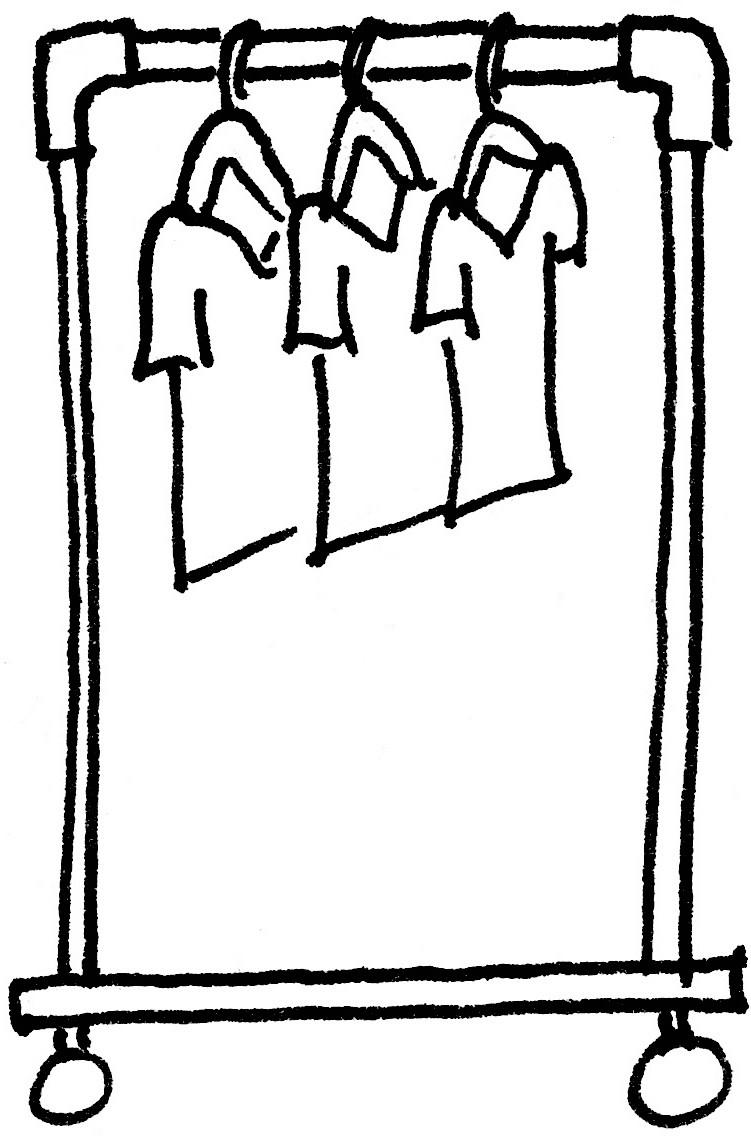 - Eleanor Zwart Artwork by Eleanor Zwart
- Eleanor Zwart Artwork by Eleanor Zwart
Oyster River High School strives to put trust and value in its students’ freedom. We have things like open campus and an administration receptive to student input, both privileges not shared by students at many other schools. Administrators will even invite students to share their opinion or join a committee. However, in the past four years of my time at ORHS, I’ve seen major issues in how power is distributed and how students are prepared for the world.
These issues push me to believe we need signif icant change in how our school operates and how we craft policy. ORHS needs a forum for students to discuss real issues in the school and for students to have a large hand in how the school is run. This system is integral to having a school system that creates effective and involved citizens.
The purpose for classes like Citizen’s Education, and pretty much all social studies courses, is to cre ate students who are ready to be responsible mem bers of a democracy. How, though, can students learn democracy if they don’t practice it?

When I was elected to the senate for my senior year, I was excited to make a difference and act as a voice for the students. I was ready to bite anyone who might suppress student opinion. Little did I know, I had no teeth.
I felt discouraged about my role on student senate from the beginning. However, things started to change after I began an independent study on democracy in high schools. This study culminated
with a visit to Souhegan High School (SHS). SHS is unlike any school I’ve seen. I knew this the mo ment I entered its unlocked doors and saw students working and socializing in hallways, common areas, and work spaces. These students were given power that few high schoolers have. They were made re sponsible for their education and empowered to be leaders in SHS and the surrounding communities.
“Being in an environment where you know your voices are heard, and val ued, it encourages a community where students want to be more involved, and truly care about the people and places surrounding them.”
At SHS, I met a number of students with varying degrees of involvement in their school government, called Community Council. One such student, a senior named Erin McCool, had valuable insight on the philosophy that drives SHS. “Souhe gan’s model promotes student involvement in the school as a whole because from the core founda tion of our founding documents, it promotes an environment where students are seen as equals, and allowed opportunities to grow as people as a whole, not just as a student.”
McCool has her own perspective, based on her experience at SHS. “It is important to engage students democratically because it allows kids from
an early age to learn important life skills, that will later allow them to best fulfill their responsibilities and privileges as a citizen. I have been able to learn how to gather knowledge, debate respectfully, speak publicly, and vote accordingly, all skills that I know will serve me well in the next chapters of my life.”
Our student senate is democratically elected by the student body, but it lacks meaningful control in our school. The students have been sensing their lack of power, too. In this year’s elections, the freshman class suffered an issue of students stuff ing the ballot box to try and elect a joke candidate. While this may seem like a stupid and thoughtless prank, it indicates that the freshmen are not taking their student government as seriously as in past years.
If we want to teach democracy in schools, we have to engage in the real thing. The senate is a nice gesture—a simulation of what a democracy looks like—but it’s time for administrators to share power. Not just with students, but with faculty too.
“Being in an environment where you know your voices are heard, and valued, it encourages a community where students want to be more involved, and truly care about the people and places surrounding them,” says McCool. Giving students agency in our everyday life will have radical bene fits for our community. When young people know that their vote and their voice means something, they will care more about their school and commu nity.
At Souhegan, students are a part of a Commu nity Council, sharing seats with faculty, adminis trators, and even some community members. This council oversees most of the policy making that is normally handled by a school’s administration. For example, they are currently evaluating and craft ing a proposal on how to improve security on SHS grounds.
SHS students care deeply about their school, and are empowered to involve themselves in their dem ocratic process every day. Council members will frequently work with students to create policies and
see them to fruition. In addition, the Council has a unique relationship with the district’s school board. When a proposal that is discussed in the Council is determined to be above a decision making level normally appropriate to administrators, the Council will instead craft a formal recommendation of how the school board should vote. To date, their school board has not voted against a recommendation.
young people know that their vote and their voice means something, they will care more about their school and community.
The purpose of my visit was to learn more about their system and consider whether it could be relevant to Oyster River. My findings there were exciting, to say the least. SHS was formed in the early ‘90s, and while it was always intended to have its unique education style, our two schools have always shared a number of similarities in teaching philosophy. For example, we both have heteroge neously grouped classes and privileges like open campus. Oyster River is a great school, many of its policies are many years ahead of other schools in the state, but there is now an opportunity to make our school even better.
Oyster River is ready to make serious changes. Such a transition has the potential to be quite chal lenging, as sharing power is never an easy task, but it is absolutely necessary if we hope to stay on the forefront of education. Despite the size of the task, ORHS is a school with strong values that will only become stronger with democratic control. Students are ready to have their own Community Council, which will engage them to be more conscious, mindful members of society. With the massive political divides that we see in modern America, Oyster River High School’s goal of creating effec tive citizens is more important than ever. Giving students a binding democratic voice is the only meaningful way to achieve such goals.
ArtworkWhen
“It is important to engage students democratically because it allows kids from an early age to learn important life skills, that will later allow them to best fulfill their responsibilities and privileges as a citizen.”
-Nicholas Dundorf
by Nicholas Dundorf
When I first began writing this article, I was strongly in favor of weight ing GPAs at Oyster River, specifically AP classes. But after talking to people and doing some research I completely changed my mind. Here’s why:
Having a weighted GPA means that the difficulty of your classes is taken into account when calculating grades. For example, a B in a regular class is the equivalent of a 3.0 GPA, but a B in an honors or AP class could be the equiva lent of a 3.5 GPA.
A typical weighted GPA system puts more value on the core subjects (Math, Science, English and Social Studies), and fails to place value on electives such as drawing, acting, and culinary. At Oys ter River, the philosophy is to create an inclusive and well-rounded learning environment. Weighing GPAs puts more value on grades and less on the true value of learning, which doesn’t fit into Oyster River’s teaching philosophy.
Oyster River has been moving fur ther and further away from the typical measures of successful learning. A few years ago, they removed class rank. There is also talk of switching to competen cy-based grading in the future (See Devan’s Article “Competency-Based Ed ucation” from MOR 2017-18 Issue #2). Both of these changes support their goal to create a supportive learning environ ment where you’re not just working for a grade. Changing to a weighted GPA system would show students that there is more value in the numbers associated with their grades than actually learning
and trying your best.
Not everyone is a good test taker. Some people can never study and still coast through classes, and others have to study for hours just to pull off a C+. Right now our academic system doesn’t reward the students who are trying really really hard, it just rewards the students who’ve been able to get high grades..

“Some of the special education stu dents who have a class that some perceive to be an easy A might work two or three times harder than that kid in the AP Calc class to get the grades that they get, and so how do you weight that,” said Heather Machanoff, ORHS Counseling Director. Weighing GPA would further divide the students, and create a more stressful learning environment.
The line between hard classes and easy classes is very blurry. This is especially true at ORHS because we are a hetero geneous school, meaning we don’t have levels in classes (like college prep, Inter national Baccalaureate (IB), and honors). “Any student who’s taking Algebra 1 covers the same material. In other schools they have levels cover different amounts of material… it tracks students,” said Machanoff. “You can have situations where a student maybe isn’t doing great freshman year so they get tracked into a lower class, and then they are kind of stuck there,” said Machanoff.
This is one of the reasons ORHS struggles with how they would theo retically weight classes. Other schools typically weigh the high-level classes more than the lower ones. Because Oyster
River doesn’t have this, the question of how they would weigh GPAs arises. “[Some] say math should be weighted higher because that’s harder. Well, maybe for some kids, but for some kids it’s not,” said Machanoff. “If you look at some of the pottery produced out of our art department it’s amazing. So how do you compare?”
Megan Hutar (‘18) believes that pretty much everyone at Oyster River is a hard worker, but she acknowledges the fact that a challenge can help push people to work towards their goals. She also recognizes that the meaning of an A fluctuates teacher to teacher. “Many students could also argue that certain teachers are harder than others, and I agree with this, but there is no way to evalu ate that objectively with a numerical grade,” said Hutar.
Hutar is in favor of ORHS weighing their AP classes.“I think they make sense in a school with AP classes because an A in an honors class might be harder to achieve than an A in a regular class,” said Hutar. “I think it would be great if our school did it for AP classes but not the other ones that are offered.” This is a popular argument, but administration feels that this wouldn’t solve the problems.

We all want the same thing, to do well in school and be successful, but this doesn’t mean that it’s ever going to be completely fair. I believe that getting an A in an AP class is harder than achieving an A in a standard class no matter who the person is. However, some students are very academically gifted and are able to do the minimum and still get good grades.
Taking an AP class just because it’ll look good on your college application isn’t a good decision. Not only will it cause you more stress, but if you’re only in it for the credit/ grade it likely isn’t going to be enjoyable.
Sarah Levine (‘18) is against switching to weighted GPAs. “Though I understand the argument to make [GPAs] weighted … I still disagree with making such a change. I am someone who feels strongly about taking the courses you want to take. I don’t believe in taking certain AP or challenging courses that you are not interested in but are just signing up for because they look better for colleges,” said Levine. “To me, it is important to make the most of your high school experi ence and study what you’re passionate about.”
College is a common concern for high school students. And many believe that switching to a weighted GPA would make then look better to colleges and may even get them into their top school, but that’s not true. “Colleges do their own GPA calculation. Even if you have a weighted GPA and you apply to a school, they still take apart your transcript and they apply their own weight ing system. [Not weighing GPA] doesn’t hinder our college acceptances,” said Mach anoff.
At the end of the day, it really doesn’t matter. This a very small portion of your life and a few years out of high school you’ll see that your high school GPA makes no differ ence in the quality of your life. What will matter is your work ethic, and your passion. So if you want to take harder classes to challenge yourself, go for it! Just don’t do it for the grade.

DARIENNE MERRILL
Great Bay Community College
Major: Psychology
Sydney Litchfield: Cool Math Games and Photoshop
Cam Schiavo: retrieving Shakespearean books Anna Stewart: adulting
NOAH CLEARY
University of New Hampshire Major: Chemical Engineering
Laurel Gordon: the rights to Alexander Cleary Tucker Henry: szn of eating
MACLANE JENNISON
University of New Hampshire Major: History Aidan Hackenburg: Cheating Mr. Laforce: Years of fake passes Tyler McKenna: A fifth year
2 Years at Great Bay, then 2 years at University of South Florida
Myles Carrico: Air freshners for Hannah’s whip. Henry (Hank): the senior core
WILL GEORGE Quinnipiac University Major: Finance
I Will, will leave my will to Will. - Will
SKYLAR HAMILTON
University of New Hampshire Major: Journalism
Jordan Zercher: MOR, and spare clothes
Emma Kovalcik, Ian Miles, and Jordan: the drama department
Jack Harrington: Godspeed Taryn Fall: Applebee’s appetizers
Emma
Mrs. Hallbach: beautifully organized notes done with colorful pens, and my A2 grade
Mrs. Cathey: endless smoothies and coffee
JESSIE BARKER
University of New Hampshire Major: Mechanical Engineering
I hereby bequeath the robotics team to Jorgen Lorvig and Elodie Mitchell.
Matt, you can have what little is left of my motivation, I won’t be needing it in college.
Skyler, you will receive the following: my black belt, limited access to my dog, and of course the occasional spa day with shea and I in our dorm.
And to our dearest Kristen, we gift to you the East side (aka the good side) of the core.
MEGAN HUTAR
University of Pittsburgh Major: Pharmacy
I will the Oyster River Equestrian Team to Cecilia Drysdale, the East side of the senior core (the better side) to Kristen Mandeville, the French Club to Keirsten Neilson, and a life of happiness to Mrs. Stetson.
College of William and Mary Major: History
I leave to Alana, Lucas, and Emma Hilary the Model UN club and Gregorian Chants
To Kelsey Wiles I bequeath 100 chicken McNuggets
Rhys Webb: every single Beatles album, and The Rocky Horror Picture Show Lucas Hamilton: early morning car rides blasting In The Heights, and Ron Hilary Gould: The Curse of the Lambchops, and the color pinkTo Maggie Keenan I leave the calendar ;) and Scott’s lunge matrix
I leave behind to Phoebe, Laurel, and Kelsey the memories of Greg (RIP)
To ORGXC I bequeath Fergus, please look after him Finally I leave to Madison Hoppler two years of good XC and track races
ABBY MERRILL
Kelly Merrill: the Miss Merrill favoritism with Mr. Lawrence and the ladies in the office (even Mr. Milliken),the Merrill legacy in not 1 but 2 schools, my seat on the bus to Dover
ABBY CROOT St. Lawrence University
Major: Sports Marketing and Advertising
Jeffery Flores: breakfast burritos and sunroofs
Tori Leitz: the jersey #14
Cam Schiavo: the field hockey team
Ariel Frasca: Mrs. Cathey SALT Team: Andy Lathrop Mr. Jetty: awkward staring contests
SARA DIHARCE
Emerson College Major: Creative Writing
Jared Benoit: Take good care of the Kaya twins
HENRY BULKLEY
Arizona State University Major: Pre-Dental Taryn Fall: Brenda, tanning goggles, skewered chicken
Juliet Clark: My catapult
Abby Schmitt and Laurel Gordon: AP Physics
Ally Marshall: My lululemon wardrobe
Julia Dirks: my attendance record and an iced coffee
NATALIA PRUSZAK
Colorado State University
Major: Business Administration/Marketing Mrs. Wainwright: an apology
SARAH MUELLER
SUNY at Purchase Conservatory of Theatre Arts
Major: Stage Management
Emma K.: I leave you Caple’s coffee order. Dunkin hazelnut with regular cream and sugar. She also loves diet coke. Sofie R.: I leave you the willpower to get through senior year.
Ms. Caple: I leave you all that I know. Thank you for teaching me and being there for me through the years.
Cam S.: I leave you a lion costume.
COLEMAN MOORE
Rochester Institute of Technology
Major: Computer Science
Jorgen: I’m giving you the position of male captain to the robotics team you can also nominate someone else is the pressure of the position is too much.
Emerson Moore: I hereby give you my half of the Mavic its fully yours now feel free to crash it into a tree or keep it hidden away in a box it belongs to you now.
ETHAN KESLAR
University of New Hampshire
Major: Business Administration
Garrett Keslar: the subaru, my old assignments
Mrs. Hallbach: omlet wednesdays
Benny Caron: the hockey team
Eric Donovan: second floor bathroom
Peter Harwood: a future championship team
Carps: a rat Scott McGrath: bear Declan Daubney: hockey team if benny caron leaves
JAY RASMUSSEN
Gap Year then Southern New Hampshire University
To Kerstin Nielsen: Hope you find some other nerds to geek out with, because it is not fun to geek out alone.
To Book Club: More people. More food. Yeah, that’s it.
HARRISON RIEF
Montana State University
Major: Business/Minor in Entrepreneurship
Jared Benoit: my whip Clover Kelly: The boys
Ally Marshall: glassy lakes Jack Bishop: Kume bistro Nick Cornejo: physics class and teeebs Tekkars: winning mentality
Jake Baver: The ship Mr. Lacasse: 8:15 arrival
Shane O’Connell: senior year soccer season Carps/mayo/RAT: A sandwich for you mayo
MORGAN KELLER
Major: Archaeology
I leave my position as first chair violist to Carly Hoag and Jane Spear, on the condition that they do NOT start calling the position “The Morgan.”
SOPHIA GRAFF
Gap year teaching English in Costa Rica Ally Marshall: The Senior Core ORGXC: A state title Kelsey Wiles: 100 Chicken Nuggets Sadie Garland: Feminist Rants Si LaBelleBrown Brown, Carl Zent, Will Graff and Carlson: The Carpool Rohit Kantipudi: an F in AP Bio Jane & Kate Spear and Liesey Parsons: 5 a.m. swim practices
JULIA RAVENELLE
Becker College Major: Exercise Science Ally Marshall: mumma, the hockey team, the lacrosse team, the core, and everything else including my will to live.
BRIANNA RYBINSKI
University of New Hampshire
Major: Biomedical Science/Minor in Nutrition (PA track) Mrs. Wainwright: an apology Mrs. Stetson: custody of my dogs
Ally Marshall & Tory Liebel: the hockey team & five lines Devan McClain & Clover Kelly: Sammy’s runs Hank: unlimited high fives!! :) Trey Martin: the core Screg: my love Mr. Jetty: a taco and a fire extinguisher
HANNAH JANE WILSON
University of Vermont
Emma Hilary: a walk down cold spring in the pouring rain & a new pair of pants Becca Shay: Nikki Minaj jams in marcia
Lomein Reid: a dead cat
Ana Szymanski: an ice cream cake
Tyler Nachilly: an unopened snapchat
Jackson Deely: Thirty Hungry Orange Turtles
Charlie Brooks: a fluffernutter shake at 7:59 pm
Ty Mountain: a veggie burger
Quinn&Ethan: the wilson legacy
Mrs. Blais: a more responsible advisory
The George Washington University Major: Communications
Emma Hilary Gould: A wig induced migraine, Jack Antonoff, the left back corner
Grace Henry: petites, floor pee, Grease “shenanigans”
Kelsey Wiles: a tunnel bun, my dream duffel, Into the Woods “shenanigans”
Phoebe Lovejoy: a map of NYC
Jackson Deely: My hand in marriage, london bridge
Indi Bagnall: Phinn, Les, and Maritza Madame: “Le Bureau” season 5 episode 14 Eli Harriton: the honor of being my favorite member of your family
Case Western Reserve University Major: Biomedical Engineering
Kristen Mandeville: Northeast side of senior core
Madeleine Triff: My All-State music and my car
Ailla Crossman: A maroon Exeter sweatshirt
Iris Ingelfinger: Chocolate for group (with almonds)
Lauren Reid and Ellie Cavanaugh: Cardi B
University of New Hampshire
Major: Environmental Conservation and Sustainability
Nathalie Paré: pretzel sticks dipped in apple juice Jack Dalton: Thanksgiving 2015 Corum Nichols: a victory royale Kristen Mandeville: all my love
University of New Hampshire
Megan Deane: Madison and all her required maintenance (please note this item cannot be returned but will include an ice pack incase of injuries) and SPOB Corinne: My volleyball windmill legacy Madison: My bedroom (to play countless hours of Minecraft in)
University of San Francisco
Major: Computer Science Aidan Hackenburg: My Plat 3 ELO, Rammus skills (you need these), and my extreme intellect
Kristen Mandeville: The east side of the Senior core Madison Hoppler: Minecraft love poems, a stack of 64 diamonds in the secret chest behind the painting, my influence at Hannafords
Shawn Kelly: My Magic: The Gathering skills
I leave my musical talent to mini Walsh, my decent math skills to Liam Weglarz, and my terrible comedic timing and skill to Chandler Norling. I leave Mr. Ervin’s guitars to Mr. Ervin, Mr. LaForce’s piano, saxophone, and flute to Mr. LaForce, the ORHS Library to the Oyster River School District, the MOR staff to Shawn Kelly, and my poor singing range to Chandler.
KARA BLAISDELL
University of Rhode Island
Major: Marketing
Cass & Kat: the volleyball team and all my love
Vanessa: pitaya bowls
Cass: A senior speech
KATHERINE MACHARDY
New England College
Major: Hospitality and Tourism Management Tristan: My snap for when you’re single Katecat2
Heather Healy: My heart and an apology for not showing up ever for A period class
Vanessa, Annie: getting kicked out of lib for being too loud Charlie: Making breakfast at 3:02am and the window on the upstairs floor
Matt: Crackers
Marian: Driving around from 5:00am-8:00am before school Clover: Emailing Aromas for burnt plastic bagels
Trey: Core
MERCEDES JEWELL
Keene State College
Major: Psychology Laurie Grant: an endless amount of thank yous and all my love forever
Mr. Kelly: the OG Advisory and all the memories that come with it Mrs. Hallbach: all of the understanding and patience in the world Ms. VanDyke: unlimited amounts of elevator rides, confidence, and all the happiness in the world Mr. Zottoli: gossip sessions and endless amounts of sass
ALIYAH MURPHY
Elon University
Major: Pre-Physicians Assistant Felicia Drysdale: jersey # 3, infinite late slips for Skelly Meghan Dirksmeier and Felicia: #doitforthebod Ally Marshall: actual permission to go in the core Lisa Richardson: an on time arrival and a coffee Devan McClain: the skin care obsession
ZACH LEICHTMAN
Syracuse University
Major: Sports Management Max Carpenter: Footy and puck captainship Ben Caron: Junior hockey or first team all-state Declan Daubney: A Eric Donovan: Impulse Grenades, V-Bucks
Andy O’Brien: My xbox username Owen, Max, Myles, Frads: My baseball legacy
Gap Year then University of New Hampshire Devan McClain: “YOFFS SZN”, “CAN I GET A HOYAA”, and vegan butter
Iris Yu: Asian #1
Jackson Deely: Bon Qui Qui and Lafesta
Emma Malesky: Glee and my tan
Vanessa Perrault: Homework pics and a Blue Raspberry Rush Joe Morell: Kimberley Wolph
COLIN TUCKER
Purdue University
Major: Chemical Engineering
Calla Tucke: the number 12
Jacob Baver: a hearty meme
Tucker Henry: a ride
Nicolas Cornejo: una chilena
Caleb Chinburg: a fire energy card
Paul Smith’s College Major: Environmental Science
Jen Hanley: My ability to never get caught, Mom and Dad (they are your problem now), and all my love.
JESSICA LEACH Indiana University Major: Neuroscience
Marian: the baby hand, juicy drop pops, lots of floam, and Deddy Mrs. Cathey: my heart
Mr. Oxnard: pill bugs and blue sand
ABIGAIL LESTER Great Bay Community College
Senior year is your best and easiest year of High School so enjoy it while it lasts!
Wentworth Institute of Technology Major: Civil Engineering
Spencer Everest: I’m leaving you my share of Forced Family Fun(FFF). Don’t wreck the Camry while I’m away. Also Katie is your problem now.
LYDIA HOFFMAN
Colorado State University Major: Natural Resources Management
Laurel Gordon: An infinitely open squat rack
Amelia Concannon: Bathroom breaks during track workouts
Devan McClain: Early morning meetings and five extra minutes to get ready before every track practice
Abby Schmitt: #9, that number has a defensive legacy
Ella Gianino: The back four and the future success of the Bobkit tens <3
Dartmouth College
Amelia Concannon: #6 (wear her proudly), bathroom breaks, and the 400
Laurel Gordon: the string bean and infinite bites of apple Devan McClain: all the coconut cream your heart desires Bobkittens: my whole heart + Steven and Meg <3 Madame: une nouvelle confidente <3 et beacoup de l’eau ;)
Gap year in Nicaragua then Simmons College Melanie Banafato: the van, the myth, the legend; the banabeep beep
Chloe Jackson: all the cookies you can eat Ally Marshall: a better sense of rhythm Clover Kelly: that familiar “fancy” feeling
JENNA SCHOLEFIELD
Keene State College Major: Early Childhood Education
Matt Cusack: Mrs. Cathey, ask her about her trip to Antarctica Edwin Jones: Matt Cusack, take good care of him for me Nikita Shiklomanov: Boston and my Tomagotchi
KENDALL BIRD
University of New Hampshire Major: Nursing
Addy: the Bird family legacy, never stop smiling Madi B.B. and Jackie Carter: the softball team KVD: lots of winning scratch tickets Madame: beaucoup d’etoiles qui dansent
XIANA TWOMBLY University of Rhode Island Major: Kinesiology Evi: Deroada Jackson: Binga Laurel: the bicep bump Devan: Winny
CONNOR MANNING University of Rhode Island Major: Pharmacy Cam St. Ours: the relay team Acadia Manning: the Prius MADDIE GLASS Gap Year in Europe
Steven Lacasse: tea leaf green & all the van jams Señor: una buena vida con jennifer y armario cuando Will sale la casa
Mr. Ricciardi: a 9:15 arrival and Wish.com
GRANT HEINE Clarkson University Major: Mechanical Engineering Tucker Henry: Another championship Nick Cornejo: A captain band Lydia Kurtiak: My barn
JACOB ZERCHER
University of New Hampshire Double major in Math and Physics Mr. Lacasse: Hopefully a better AP Economics class Rohit Kantipudi: Your SAT Physics and Math II study books Nick Cornejo: My place as first team all-state striker Henry Duisberg: Reorganizing the weight room Jake Zamansky: A promise that I will start watching all of the good movies I haven’t seen
ANNA KATE MUNSEY Fordham University Major: Psychology (Pre-law) Phoebe, Kelsey, Grace & Laurel: Fergie, the bobkittens, and best of luck in your senior season <3 Marian: a ~full course meal~ of chicken, all the cheese from the vending machine & a whole milk latte, WHOOP, beanboozled, Adobe & B free
Myles Carrico: “one bus for your ego” and Chloe
Chloe: brunches at the bean, a Plymouth xc course map, and all rights to Jill Manafato
Reed Leader: Marian Bulkley
Joe Morrell: my Ray Bans
Marian & Chloe: two train tickets to visit me in the fall Lisa Richardson and Deb Jabre: a million hello’s
PARKER SPINNEY
University of New Hampshire Major: Engineering Henry Keegan: aux cord approved Owen Fleischer: style Myles Carrico: baptism rights Jack Bishop: burn crew Oyster River: state ship Craig Nadig: senior edgewood
DANIELLE
SLAVINMassachusetts Institute of Technology
For the Oyster River Girls’ Cross Country Team, I leave the moniker “Fuicchus” (pronounced FIE-kus). IT’s for a cerTain poliTician.
For Kaleigh, I pass the torch of the 13-year streak of having a “Slavin” on the XC team. You can finish it.
For all my teachers, Ms. Machanoff, Scott, Nick, and Fergus, I leave my thanks for helping, teaching, and guiding me, and for making me smile.
Walt Jette: a flame retardant taco Devan Mcclain: the big bean and shared custody of Grady Mrs. Cathey: Green smoothies, bottle rockets and Ursa Major Eli: the safest parking spot for your awesome car! Maddy Alphonse: Our beach house Grace and Kelsey: Unlimited passion sandys Alana Ervin: Coffvee Lisa Richardson: A pen to sign late slips Mrs. Gibson: An advisory that shows up Trey: the senior core
ASHLEY LEVIS Keene State College Major: Accounting Olivia Myers: our great memories from art class and my love Tracy B: my entire heart, our mornings before school, and every memory.
Anna Sargent: my love. enjoy high school xoxo
SAMUEL DAVIES
University of New Hampshire Shoc - Dancin in The Moonlight Ike and Mike: The bat Tekkers: Sole possession of the 6 Carps: Ownership of storytime Bish: Rights to Mill Rd Kewsh: The Legacy of Observation
Virginia Tech Major: Engineering
Marian Bulkley: Laurie, my Google Drive, a kazoo, wild thoughts, Starbucks Cold Brew, a wubble, chicken, and 100 Walmart trips
Ryan Settele: Permission to enter the core Matt Williams: FaceTimes, your sweatshirts, yogurt, ukulele lessons, and custody of Ryan Settele
Gabbie Haug, Ally Marshall, Abby Schmitt: the team <3
EMERSON MCMANUS Miami University
Major: Business/Communications
Julianna Caldicott, Meghan Dirksmeier, & Ally Marshall: Straight A’s in your future math classes
Jacqueline Coxen: Another trip to London
Anna Davis: My ballet attendance record
Emma Hilary Gould & Maddy Alphonse: Stagecoach farms
MADELYN VERNO Penn State University
Major: Geosciences
The Girl’s XC Team: My sister (good luck) Alana, Lucas, and Rohit: The Model UN Team Emma Hilary and Alana: Late night readings (while the Gregori an Chants play)
RILEY CHINBURG
Oberlin College Major: Math Caleb Chinburg and Ms. Drake: Math team
Ms. Pearce and Ms. Earl: The school library
Kerstin Nielsen: The inability to geek out about musicals with anyone. Also book club.
Ms. Stetson: Purple pants so you can officially join the club
Ms. VanDyke: The math books in the library
Mr. Kelly: Noam Chomsky
Ms. Yatsevitch: Our Podcast Genevieve: Zombie Calculus Josie Chinburg: The dead cats in anatomy
KAGAN CONRAD Northeastern University Major: Industrial and Systems Engineering Alana: Gumption, My grandmother’s rosary Rohit & Lucas: What’s left of MUN Aidan & Oscar: My garbage elo Mrs. Blais: Google Drive -> New -> Arrow Next to Google Docs -> From Template -> Finance & Accounting -> For Mom Mrs. Horsley: Google Drive -> New -> Arrow Next to Google Docs -> From Template -> Letters -> Art. Jordan & Charlie: The La Catrina Fan Club
DAVID HOLMES
University of New Hampshire Major: Chemical Engineering Sarah H: My Broken Car John: My Unicorn Frisbee Sean M: A layout Bruce: The ability to make a shot Mrs Y: More in-cuts
Bryce C-B: Some ghost pepper flakes Clay: Even more ghost pepper flakes Whole basketball team: a “north south j”
I leave my will to the dude that took forever to send us my senior picture. Thanks bro.
MUNTER HADORE
Keene State College Major: Business Mr. Kelly: climbing shoes and a chalk bag
BEN BUTEAU
Virginia Tech Major: Physics Noah, even though the Corolla isn’t the prettiest car in the world. I leave her to you. Please take the time to baby her as she de serves to be. Make sure to crank the windows down slowly. Don’t grind the clutch or take my baby above 3000 rpms (she doesn’t like that). Don’t stomp on the breaks too hard, there is no abs to save you. She is rough around the edges, but she has kind soul. Please love her as much as I do.
MAX STENSLIE
Quinnipiac University Major: Biology Henry Keegan: Lake house Dunesberg: running aux Myles Carrico: Forever almost a junior Owen Fleisher: Flow Andy O’Brien: Rides Mr. McGrath: State champs Shane O’Connell- Neighborhood legacy
Max carpenter- Ernie’s soccer
SAMANTHA GOODSTEIN
Nichols College
Major: General Business

Gracelynn Goodstein: Daisy, Beau, and the Goodstein reputation of always being late.
Libby Cavanaugh: Jerseys #17 and #23 and the ‘Bull’ attitude. Gabbie Haug: My reverse chip and the goalie net.
WILL CILIA
Michigan State University Engineering
Ben C - Captainship Declan - Flow and Pauly B Kyle - The Volvo and my basketball skill Taylor and Hayden - The circle game Liam S - Corner stall and bus seat Mr. Harwood - Pit Viper Sunglasses
TYLER MCKENNA
St. Joseph’s College of Maine
Major: Criminal Justice Saddle: the fish
Kyle Landrigan: basketball warmup music and big mode
Max Lewis/Owen Tonkin: Jim the machine Quinn Wilson: 2019 6th man of the year Beeves: skiing lessons Doug MacGown: the water jug Jack Dalton: Saddle Mrs. Hallbach: 6 Mrs. Wainwright: my apologies
Patty Andersen: Shoes, the Senate Gabbe Albert: Fiction, Benson Allie Dundorf: Fashion cred
Mr. Hawley: Map or atlas (your choice)
Mr. Kelly: Blowing air out of your nose instead of laughing
University of New Hampshire
Jackson: London Bridge, Gracie Markyman: Pro super smash skills
Tuck: Ronaldo, Messi, Victory Royale, a growth spurt potion K-money: Hnuhk (he was always mine), pi, DevinSoulRunner, Marvin, mi grande baño
Sierra Wags: VIP Billie Eilish tickets, and Billie Eilish herself Juwian: Bliss n Eso, Rizzle Kicks, my MC account
Kristen: East side of the core, salami Alex and HBB: $10,000 worth of camera equipment
Carleton University
Major: Communications Lisa Richardson: the house

Karen Vandyke: my favorite musicals Jackson Deeley: new hampshire’s dairy queens
Indigo Bagnall: a soft breeze Julian Crawley: full custody of Ryan Tucker Henry: St. Lucia’s finest conch shells
Chile
Jake Baver and Kai Beaton: Two phenomenal people Tucker, Nick, and Max C: A passionate soccer program with a tra dition of excellence
CAMERON THIBODEAU
Keene State College
Major: Criminal Justice Kyle Landrigan: My 3pt shooting Joe Morrell: My passing ability
Kyle landrigan: My captaincy from the basketball team Basketball team: Championship
CASSIDY METCALF
I leave my lunch spot in the culinary room to Evie, Roni, and Ker stin, in the hopes they fill it with more nerds, my parking spot to an unlucky junior who will undoubtedly crash their car, and my hatred of PDA to all the single students out there.
